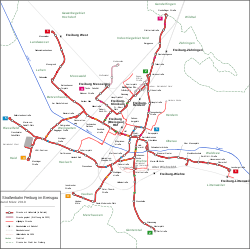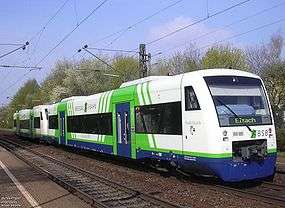Trams in Freiburg im Breisgau
The Freiburg im Breisgau tramway network (also known as Stadtbahn or formerly as Hoobl (Alemannic for Hobel)[1] is a network of tramways forming part of the public transport system in Freiburg im Breisgau, a city in the federal state of Baden-Württemberg, Germany. Opened in 1901, the network has been operated since its foundation by the company now known as Freiburger Verkehrs AG (VAG Freiburg or just VAG) and powered by electricity. Currently, the tramway network is run by five lines. The expansion of the tram network since 1980 has served as an example of the "renaissance of the trams" in Germany. At the start of 2017, 72 trams were available for regular use. Five of these were high-floored, 37 partial and 30 low-floored. Almost the entirety of the network is located within Freiburg's urban area, only a few metres of the balloon loop at Gundelfinger Straße are located outside the boundary of Gundelfingen to the north of Freiburg. In total, the trams serve 20 out of the 28 districts in Freiburg.
| Freiburg im Breisgau tramway network | |||
|---|---|---|---|
A Landwasser-bound tram in Freiburg | |||
| Operation | |||
| Locale | Freiburg im Breisgau, Baden-Württemberg, Germany | ||
| Open | 14 October 1901 | ||
| Status | Operational | ||
| Lines | 5 | ||
| Operator(s) | Freiburger Verkehrs AG | ||
| Infrastructure | |||
| Track gauge | 1,000 mm (3 ft 3 3⁄8 in) metre gauge | ||
| Propulsion system(s) | Electricity | ||
| Electrification | 750 V DC | ||
| Depot(s) | 1 (Betriebshof West) | ||
| Stock | 61 trams | ||
| Statistics | |||
| Route length | 32.3 km (20.1 mi) | ||
| Stops | 73 | ||
| |||
History
Time before trams
After Freiburg was connected to the railway network via the Rhine Valley railway from 1845, there was an intercity transport links between the Hauptbahnhof and the Wiehre Train Station, which used the "Hell Valley Railway" for the first time in 1887. From 1891, horse-drawn buses, operated by two different private companies, transported citizens throughout the town. The horse-drawn buses were used on three lines, Lorettostraße to Rennweg, Waldsee to Hauptbahnhof and Siegesdenkmal to Horben and eventually were replaced by trams, except between Günterstal and Bohrer.[2]
_0548.jpg)
On the 8th May, 1899, the city council made the decision to build an electric transport system in Stühlinger. Reasons for it included the University of Freiburg's increasing requirement for light and power and the planned refurbishment of the town's trams. A survey carried out in 1899 by the city council resulted in a power requirement for more than 20,000 incandescent lamps. (Quote)
The acting mayor at the time Otto Winterer decisively ensured the fast implementation of the trams. The concession for powering the tram was safeguarded by "Direktion des Elektrizitätswerkes und der Straßenbahn", the name of the former VAG company.The tasks of building electric centre for producing light and power and the tramway were assigned to the Siemens & Halske of Berlin. Because the supply of hydropower in the environment was too low, the decision was made to generate electricity by means of a steam power plant.
The tram's planners saw Freiburg Bächle in the Old City as problematic, since it was feared that the trams could fall into the Bächle in the event of a derailment. In addition, it had to be ensured that the entrances on the Bächle side remained closed. In the end, the advice of a senior engineer from the trams in Hamburg project, who "could not recommend the building of platforms next to the Bächle under any circumstances" and was pleading that the Bächle be covered. This was ignored in order to preserve the Bächle as a landmark of Freiburg.[3]
Not included in the construction contract were the conversion and restoration of the streets after laying the tracks and erecting the depot at Urachstraße. This work was undertaken by the city and municipal building authorities. At the same time as the tram network, Freiburg had access to electric road lighting which was powered by the same electricity plant. It still exists to this day and is located on Eschholzstraße, away from the tram network.[1] From there, a subterranean supply led to the corner of Betheroldstraße and Wilhelmstraße and another to the square in front of the Johanneskirche.
Initial operation
On Friday 30 August 1901, the first test run took place,[4] with the first public serving trams operating in the autumn. From 14 October 1901 on, the two lines A and D went into operation before lines B and C, which opened on 2 December 1901. The original length was nine kilometres and had 34 stops. The latter two routes were only able to operate once the Schwabentor had been converted. For the two-tracked tramway, it was extended, similar to that of the Martinstor, with a second passageway.[5] At first, however, the lines were only used for internal purposes and were not prescribed to trams. Freiburg was the fourth tram network installed within the Grand Duchy of Baden. In contrast to the older networks in Heidelberg, Karlsruhe and Mannheim, which were all electrified three months before the plant opened in Freiburg, trams in the Breisgau were powered by electricity from the outset and used lyric current collectors.
The power plant opened on 1 October 1901 and regularly produced direct current. In the first year, 61 percent of the 177,000 Kilowatt hours were used by the tram network. This was until 1933, when it received its own supply. At the start, this is how the network ran:
| Line | Route | Cycle | Journey time | Turnaround time | Courses | Stops |
|---|---|---|---|---|---|---|
| A | Rennweg-Lorettostraße | every 10 minutes
between 7am and 9am every 5 minutes |
14 minutes | 40 minutes,
between 7am and 9am 35 minutes |
4 / 7 | 16 |
| B | Hauptbahnhof-Lorettostraße | every 10 minutes | 13 minutes | 40 minutes | 4 | 11 |
| C | Hauptbahnhof-Bleicheweg | every 10 minutes | 12 minutes | 30 minutes | 3 | 10 |
| D | Rennweg-Günterstal | every 15 minutes | 23 minutes | 60 minutes | 4 | 21 |
Lines A and D ran along Habsburger Straße, Kaiser-Joseph-Straße and Günterstalstraße, while the section Line D alone served along the entire length of Schauninslandstraße. Lines B and C both followed Bismarckallee, Bertoldstraße, Salzstraße, Straße Oberlinden and the Schwabentorring until its southern end. From there, Line B alone served Hildastraße and Urachstraße, whilst Line C followed Schwarzwaldstraße to the east. For train crossings, seven evasions were accessible on the single-track east-west route.

During the morning peak, up to 18 trams were used simultaneously, whilst nine others were in reserve. In the inner city, a more dense supply resulted from the superposition of Lines A and D. There was on the single Double-track railway of the network between Rennweg, now Hauptstraße, and Lorettostraße up to 16 trips per hour. On the interchange Lorettostraße-Günterstal, which was originally cross-bordered, the only intermediate passing loop was at Wonnhalde. As a single line, the one to Güterstal, as was the case at the time, was operated from the outset by a trailer car. For this purpose, there was a transfer line at the two terminals of Rennweg and Günterstal. There were four open summer carriages available for the strong holiday traffic during this season.
The section serving Hauptbahnhof and Schwabentorbrücke was served by twelve cars an hour. However, due to the single-track infrastructure, the trams on lines B and C always ran very close behind each other.
An operational feature from the earlier years was the level junction of the interurban route to Günterstal with Höllentalbahn, which had not yet been electrified. This was located on Günterstalstraße, a few metres south of Lorettostraße and Urachstraße.
From as early as 1902, the tram was able to transport more than three million passengers. The horse-drawn bus lines in their last full year of operation in 1900 had transported a mere 50,000 passengers. In the same years, Lines B and C were extended from their former endpoint at the Hauptbahnhof by approximately 200 metres to the northwest at Lehener Straße.[6] Heading towards Lehener Straße, trams were still signposted for the Hauptbahnhof, although they continued from there to a stop. This should have served to make the orientation easier for locals.
Within the inner city, the operating company introduced a uniform tariff of ten pfennigs in 1902. This was the only reason for a one-off transfer to Bertoldsbrunnen junction (colloquially called Fischbrunnen, or Fish's Well), Schwabentorbrücke and Lorettostraße. The fee for the route from Günterstal to Lorettostraße was ten pfennigs. It also cost 20 pfennigs for trips beyond Lorettostraße. Passengers were asked to keep their money readily available for payment when they disembarked and give it to the conductor.
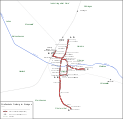
First extensions

The 15-minute trip to Günterstal proved to be inadequate for the high demand on this service, which was why the operating company had already installed two additional passing points at Waldhüterhaus on Schauinslandstraße and at Günterstaler Kreuz. This then brought the trip time down to 10 minutes. In order to further increase capacity on this route, three more summer trailers were put into operation in the same year [11]. Soon, the first extensions were installed. At the beginning of the summer schedule in 1905 by Alter Messplatz, also called Bleicheweg, was added to the loop at Stadthalle - the first terminal loop in Freiburg. The terminating station at that point was Waldsee, named after the waters in the recreation area of Möslepark. The name of the area of Waldsee emerged much later.
In the following year, the two-track expansion of lines B and C, with the exception of the short single-track section between Bleicheweg and Waldsee, was completed.
In 1908, both of the newly constructed stretch of tracks between Hauptstraße and Okenstraße, and Lehener Straße to Güterbahnhof went into operation. The latter was located on Breisacher Straße and Hugstetter Straße to Hohenzollernplatz (now Friedrich-Ebert-Platz). The route followed along the course of Heiliggeiststraße and Friedhofstraße to the terminating station of Güterbahnhof on the corner of Waldkircher Straße/Eichstätter Straße. The route was designed to be double-tracked right from the start for five-minute cycles.
Further extensions after 1909
When the new bridge from Siegesdenkmal, vie Friedrichring, Friedrichstraße and Hauptbahnhof to Stühlinger was commissioned, a fifth line was introduced in 1909 using Arabic numbers. The new Line 5 operated on a ten-minute cycle and used the "Blue Bridge" to cross the main railway line.[8] In Stühlinger, the terminal loop was built around the Herz-Jesu church. Further destinations included the districts of Haslach, Herdern and Zähringen as well as a short extension in Wiehre:
- 1910: Lorettostraße - Goethestraße and, after completion of the new railway underpass Komturbrücke, Rossgässle (today Okenstraße) - Reutebachgasse
- 1913: Stühlinger Kirchplatz (today Eschholzstraße) - Scherrerplatz
- 1914: Siegesdenkmal - Immentalstraße

Zähringen had only belonged to Freiburg from 1906, the tram connection was part of the Merger treaty.[9] The route through Herdern forced the introduction of a sixth line.
In addition, four other stretches of track were already being planned, but could not be implemented because of the First World War. It was planned that a line connecting Johanneskirche and Reiterstraße, as well as one between Stühlinger Kirchplatz and Hohenzollernplatz via Eschholzstraße, and from Betzenhausen and Mooswald districts.[10]
Furthermore, an overland stretch from Günterstal via Horben and Schauinsland to Todtnau was being planned.[10] There, the route was going to connect a metre gauge train line to Zell im Wiesental. The planners had hoped for a quick connection to the tourist friendly Southern Black Forest.
First World War
During the First World War, a large part of the workforce was conscripted for military service. Of the staff, which originally consisted of 133 employees, only eight of them were retained. As a result, women were employed for the first time by the Armed Forces from 1915.[11]
After the war had broken out, the tram network was needed to transport the wounded to numerous lazarettos across the city. As a result, a new railway connection was constructed from Zollhallenplatz, through Neunlindenstraée and Rampenstraße to the remote military section of the freight station. The trams intended for transporting injured people were waiting for the lazaretto trains at the loading stations. The carriages and sidecarriages were able to transport twelve heavy wounds.[12] A total of 20,779 injured soldiers were transported. After the First World War, the track through Neunlindenstraße served as a shortened form for many years to link the former railway track at Kaiserstuhlstraße.
A further connection between the trams and the Grand Duchy of Baden State Railway arose in 1917 in the civilian part of the Güterbahnhof. This track led from the terminal station, which was located at the mouth of Eichstetter Straße into Waldkircher Straße to Güterbahnhof, in order to enable direct reloading. The company therefore procured ten freight trucks and rebuilt the three open summer carts 102-104. The connection still existed until the start of the 1980s, when the GT8K motor coaches were delivered to Freiburg via a partially four-lane line.
In addition, the company pushed the two-track expansion of existing routes. Thus, the second track between Wonnhalde and Wiesenweg went into operation on the route towards Günterstal at the end of 1913. In the autumn of 1917, the section followed from Silberbachstraße to Wonnhalde.
During the war, a severe accident occurred immediately after an air attack on the level crossroads at Hellentalbahn. On 12 October 1916 around 9:30 pm, the driver of a tram travelling into the city did not see the closed barrier at night and collided with a railway train travelling uphill. The tram numbered 32 and the booth were smashed, the driver was severely injured. The conductor and the only passenger escaped with only minor injuries.[13][14]
Period between the World Wars
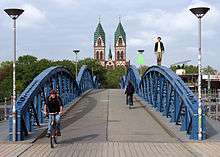
In 1919, the operating company combined Line 5 (Siegesdenkmal - Scherrerplatz) and Line 6 (Siegesdenkmal - Immentalstraße) to the new line 5 from Scherrerplatz to Immentalstraße. From as early as 1921, there were already six lines when the terminus of Line 3 was moved from Goethestraße to the stop at today's Musikhochschule and a new Line 6 from Schwabentorbrücke to Goethestraße was introduced. In the same year, the colour coding of lines was also introduced in order to facilitate the orientation to the passengers.[15]
Because of the Hyperinflation in the Weimar Republic, daily passenger numbers decreased from 40,000 in 1919 to under 3,000 in 1923. At the same time, the price for a one-way journey increased from 15 pfennigs to 100 billion Reichsmark. Thus, the tram became increasingly unattractively and an adjustment of the whole enterprise was imminent. Line 6 was discontinued on 16 October 1916 and the cycles of the other lines waned. The situation only improved when the Rentenmark was introduced in November 1923. On 22 December 1924, Line 6 was reopened between Schwabentorbrücke and Goethestraße.
In 1925, a further extension went into operation in the suburb of Littenweiler, which had been incorporated in 1914. It was to be opened in the same year as the Merger treaty and was one of the reasons for the community giving up its independence.[16] However, it had to be delayed by eleven years because of the First World War. At times, an alternative route through the southern-running Waldseestraße was considered. The course of this would have led to the centre of Littenweiler, however, directly after the loop at Stadthalle, a further crossroads with Höllentalbahn became necessary. After the line was extended to Littenweiler, the garden city of Waldsee, which had only been established after the First World War, also profited. It closed the settlement gap between the Wiehre and Littenweiler and therefore from the beginning had a connection with Freiburg city centre. In the same year, the first motor bus from Freiburg was set up from Hohenzollernplatz to Betzenhausen.
In 1928, the operating company built the last part of the new stretch of track between Rennweg and Komturplatz, where a second depot was opened at the same time. In return, the operation of the short branch line between today's stop at Rennweg and Güterbahnhof, which was for the first time on a passenger route was abandoned.
After the Schauinslandbahn was opened on 17 July 1930, the tram's directorate finally applied for a two-track extension between Wiesenweg and Günterstäler Tor on 23 January 1931, in order to improve the feeder service to the Talstation. The company also planned a four-kilometre long new stretch of track to connect the mountain railway network to the tram network.[17] Die Gesellschaft plante außerdem eine vier Kilometer lange Neubaustrecke zur Anbindung der Bergbahn an das Straßenbahnnetz.[18] At the terminus of Talstation, a terminal loop was built in front of the station building. In doing so, the side carriages had to be suspended in Günterstal and motor cars had to be operated on their own up to the Talstation. The high costs for the maintenance garage in Günterstal and five additional rail cars led to the decision of using this connection as an alternative to the bus routes.
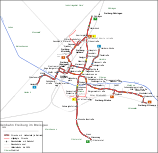
Also in 1931, the first complete shutdown of a section took place when the route leading to Goethestraße went out of service. Line 6 served from then on between Schwabentorbrück and the Wiehre train station. The section between Wiehre train station and Lorettostraße remained as an operational route to the depot.
From 1933, members of the SA and the SS as well as members of the Hitler Youth received a tariff reduction by one unit price of ten Reichspfennigs on any route. Jews were forbidden from using public trams.[19]
On 8 November 1934, the facilitating of operations in a southern direction led to a relief for the tram network. As a result, the level crossing was no longer in use. The main railway line crossed the Günterstal section at Holbeinstraße at Sternwaldtunnel. Last but not least, the tram company was able to complete the two-track expansion of the route to Günterstal by closing the gap between Lorettostraße and Silberbachstraße. The neutralisation of the railway also affected the tram network. Because the Wiehre now had access to a new train station on Türkenlouisstraße. At the time, there was no direct connection between Höllentalbahn and Line 6.
From 1938 to 1943, the annual number of passengers doubled to more than ten million passengers as a motorised private transport almost came to a standstill as a result of the crude oil crisis. However, no new vehicles could be procured.[20] In order to maintain the network, in the years of 1942 and 1943, 43 of the original 101 stops had to be closed. After six years of operation, Line 6 was reactivated from 196, and connected Schwabentorbrücke to Lorettostraße. The loop at today's Stadthalle no longer served there from 1938/39 in accordance to the plan, since trams on the reinforced Line 3 stopped now as Römerhof.
In 1943, the city council decided to introduce the trolley bus as a third mode of urbanised transport after diesel had become scarce to operate buses.[21] First of all, bus Lines B (Johanesskirche to Haslach Englerplatz) and C (Johanneskirche to St. Georgen) and, optionally, the second tram network had to be changed over to the entire tram network. Construction began with the setting of the first overhead mast on 1 August 1944. As a result of the Second World War, there were delays to the overhead line material and ordered vehicles. After the war, construction was not continued.
Second World War and Post-War era

During the air attack on Freiburg on 27 November 1944, several vehicles as well as half of the overhead network were destroyed.[22] At the time of the attack, there were around 30 vehicles in evening traffic in service. Amongst others, rail car 1 was destroyed at the railway depot, car 7 by detonations in the Nord depot and two sets of carriages from vehicle 53 and the side carriage of 110 in front of the City Theatre. Carriage 44 and side carriage 107 were hit at Bismarckallee. A further 26 vehicles were badly damaged by the bombs.
From 15 April 1945 onwards, all trams were stopped as the electrical crossing had been destroyed during the war. From as early as 26 May 1945, the operating company resumed the Holzmarkt-Günterstal and Oberlinden-Littenweiler routes after repairing the tracks and overpass on these slightly damaged sections of the route. After a temporary bridge had been erected for the Rheintalbahn at Komturplaty, the entire Zähringen-Günterstal route was up and running again for lines 1 and 2 from 4 October 1945. Line 5 was interrupted by bombing on the Blue Bridge until 1948. From 1 September 1946, a shuttle service had been established.
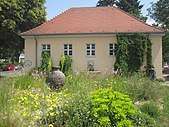
Reconstruction plans included numerous varieties of trams. Ultimately, it was decided to maintain the original routes in order to preserve the accessibility and importance to the city centre. A changeover to trolley bus operation was always critically seen by planners after it failed to start during the Second World War.[23]
The trolley bus operation in a densely built city centre can never reach the performance of a railroad
— Planner of the City's Tram Network, 1953
In 1950, the connection between Schwabentorbrücke and Lorettostraße finally lost its line traffic, but remained as an operational route to the depot until 1959.[24] Due to the removal of Line 6, there were only 5 operating lines. Line 5, however, experienced a further 300m extension from Immentalstraße to St. Urban church,[25] a further extension at Richard-Wagner-Straße and Hinterkirchstraße to Zähringen were unable to implemented.
Until 1959, additional services were provided after evening shows at Theater Freiburg, the so-called "Theaterwagen". They travelled from the tri-track station in Bertoldstraße to the Wiehre, Zähringen and Günterstal.[26]
Unidirectional operation and closure of Line 5
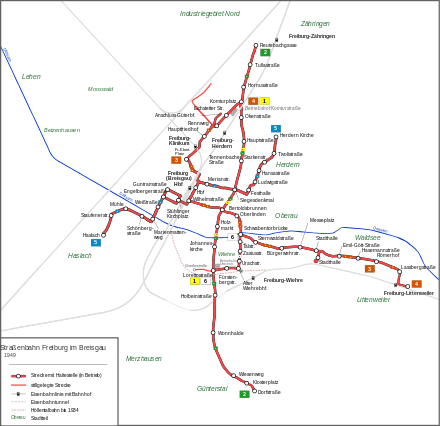
The lack of managers and desire to save jobs led to the commissioning of the so-called "Sputnik trams", which were named after the first artificial earth satellite in 1957. They had the same capacity as a two-axle carriage and side carriage but could be handled by one conductor using a one-way embarking and disembarking system. They were also the first Freiburg uni-directional vehicles but could only be used on Line 4. A provisional triangular junction had been set up at the terminus station at Littenweiler. They had already been using the turning loop instigated in 1954 at the other end of the commuter station. Another novelty of the early 1950s were the three-car coaches, consisting of a motor coach and two side carriages.
At the end of 1961, the operating company closed Line 5 for "economic and traffic reasons" and replaced it with the then bus line H. The reason for the decommissioning was, among other things, the poor introduction into the traffic area. A conversion to a more efficient route with its own railway body was therefore not possible. In addition, modern traction units could not be used on the curvy track. Thus, as in the early days, there were only four lines.
In order to spare the cumbersome marshalling operation at the triangular junction of line 4, the VAG installed a turning loop at Littenweiler. This was because of the lack of space at Lassbergstraße, meaning that Littenweiler station lost its tram connection. In the district of Brühl, at the other end of the line, a new block of flats was opened on 20 December 1962[27] at Offenburgstraße and Hornusstraße, which is still used in a clockwise direction.The old loop at Komturplatz did increasingly prove to be a hindrance to traffic because of the cramped situation.[28]
By shortening the track in Littenweiler, the network had shrunk by almost 30 percent within a few years, from 19.7 kilometres in 1945, to 14.2 kilometres in July 1962. In 1966, the city tram produced their first unmanned traction coaches with a red "S" on a white background. However, due to safety reasons, the side cars and most of the older units had to continue to operate on the basis of their manually operated doors. Nevertheless, individual units which had been procured before 1966 were also adapted for one-man operation.
Price struggles, discussions on decommissioning and further rationalisation
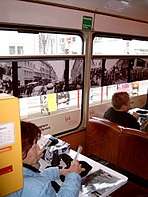
On 1 and 2 February 1968, the so-called Freiburg price struggles provided nationwide attention. At that time, some 2,000 people protested against price increases, occupied Bertoldsbrunnen and thereby stopped all trams. Their resistance however was unsuccessful.[32]
Whilst many other cities discussed the decommissioning of trams, Freiburg tended to maintain and modernise towards the end of the 1960s. In 1969, due to the above-average urban planning to the west, a first general traffic plan was adopted. New buildings formed a decisive approach to promote the maintenance and expansion of inner-city tram transport.
In 1971, a first small series of modern eight-axle articulated trams manufactured by Dueweg came into use with a view to further expansion. They could also be operated single handed and transport exactly as many passengers as the mutli-staffed three-car or four axle units with two-axle side cars. The articulated trams were specially designed for Freiburg's narrow streets with a four-axle centre wagon and a saddle-mounted end car with a bogie.
In the same year, however, a rationalisation commission was convened, which was to examine a complete changeover to bus operation.
This is one thing, however, one can completely ignore nowadays: the time of the streets is over. In the future, they will be increasingly degraded in our cities.
— Interim Report of the Rationalisation Commission in 1971
The municipal council finally confirmed the general public transport plan of 1969 with a large majority in 1972. Especially for the western districts, they still sensed a connection with trams was more sensible. A special feature of the city was the introduction of the pedestrian zone on Kaiser-Joseph-Straße in November 1972. In contrast to the recent trend, motorised traffic from the Old City was forbidden and only trams were allowed.[29] From then on, investments were made into the modernisation and acceleration of the existing network.
Whilst the inner city ring was being constructed, a single-track parallel section across from the Greifneggring was put into operation between the Schwabentor and Schwabentorbrücke. At the same time, the existing stretch across the Schwabentorring had bene restored. The reason for this measure was the comparatively smaller width of the Schwabentorring, which did not have enough space for a separate track unit and two lanes for traffic. The additional possibility of the so-called Schwabentor loop was also considered through this neutralisation. Due to the connection between the older and newer routes, trams heading towards the city centre from Littenweiler could be reversed before they reached Schwabentor.
On 17 March 1978, the first groundbreaking ceremony for the (almost) urban railway standards with an independent railroad track was extended to Landwasser by Mayor Eugen Keidel and Secretary of State Rolf Böhme. At the start of the 1980s, the first existing stretches of track were given their own body, such as the section between Komturplatz and Zähringen.[17] In 1981, the next series of modern articulated trams ended the side carriage operation and thus the Schaffner era.
Era of the city railways and "environmental season tickets" from 1983/1984
On 9 December 1983, a new stretch of line was opened heading towards Padauallee is seen as the start of the city railway era. At the heart of the so-called Western Expansion was Stühlinger bridge, also called City Railway Bridge, which was built over the Rhine Valley Railway and the Höllentalbahn. Since then, the new stop of Hauptbahnhof (main train station) has enabled direct access to the railway lines. In the same year, the VAG increased the voltage from 600 volts to the conventional 750 volts of direct current. When Line 5 was introduced, a larger line network took place as did the individual colour coding of the routes. These were now visible in the form of roll signs on each tram. Line 1 replaced Line 4 as the main line, with the newly introduced circle routed Line 3, there was also a second line on which trams could be used. However, during peak times, trams travelling to the terminus at Reutebachgasse could only travel in one direction north of Hornusstraße.
At about the same time, a nationwide debate began concerning the introduction of a cost-effective and transferable "environmental protection monthly ticket", based on the system used in Basel, where it had been operational since 1 March 1984 and quickly adopted in other Swiss cities such as Bern and Zurich. Associated price reductions were countered by passenger growth, which nevertheless led to improvements in the company's business. Many German transport companies, including VAG, did not fit into the concept of its high publicity. They were supported by the former Association of German Transport Companies, the municipal top associations and large sections of the scientific community who frequently and repeatedly warned against the introduction of these tickets."One shied away from new ideas with new risks, was unable to find a general offer for the offensive and therefore conjured up everywhere the fact that environmental issues were only a flop and led to more deficits".[30]
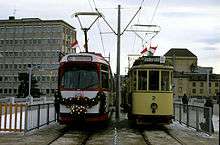
On 24 July 1984, the municipal council decided to introduce the first "environmental protection monthly ticket" despite the VAG rejecting the proposal. This system started in October 1984.[31] At the same time, prices were reduced by up to 30 percent and the price for the transferable environmental subscriptions was set at 38 Deutsche Mark, or for concessions 32 Deutsche Mark a month (the non-transferable monthly ticket cost 51 Deutsche Mark and originally increased to 57 Deutsche Mark in 1985).
This move of introducing a cost-effective and transferable monthly ticket led to a rise in passenger numbers by 12 percent in 1984 and by 23 percent the following year, this meant by five million to 33.8 million passengers in 1985. Despite the considerable price reduction, the VAG made an increase of 250,000 Deutsche Mark in 1985 alone.[32] Within four years, the number of environmental subscriptions sold rose from 60,500 to 309,000.[33] This introduction proved to serve as a breakthrough for German transport companies: "After Freiburg, the trend towards environmental subscriptions could no longer be stopped across Germany."[33]
In addition, the Transport Community of Freiburg was founded in 1985, together with the rural districts of Emmendingen and Breisgau-Hochschwarzwald, leading to Freiburg not complying with the norm of having multiple tariff zones but instead had only one.[32] The Transport Community of Freiburg, which was purely company-oriented, was a predecessor of the Regio-Verkehrsbund Freiburg (RVF) and was founded in 1994 according to the usual models used by transport associations.[34]
The passenger increase by almost a quarter within a few months was able to be managed relatively well by the readily-available tram units. However, because the number of passengers using the network drastically increased in 1985, which was not anticipated by the VAG, ten used GT4-trams from Stuttgart's tram network had to be taken on by the VAG. The reason for this was because of the conversion to the Stadtbahn in Stuttgart replacing trams. They were, therefore, the first and only used trams in the history of VAG to be purchased. A novel feature of Freiburg was the use of multiple units and the division of leading and guided units. The trams, referred colloquially as "Spätzlehobel"[35] which were always used in Freiburg in their yellow and white Stuttgart livery, were only replaced by new trams in 1990.
The Regio-Umweltkarte, introduced on 1 September 1991, provided for itself, and previously, its own intermediate stages, partly for jumping passenger growth. Therefore, the VAG used the outdated Sputnik trams from 1959 until 1993. The Regio-Umweltkarte in addition to its own monthly ticket, had a connection card available for travel across neighbouring regions costing 15 Deutsche Mark. In 1987, the environmental points ticket also led to a reduction in ticket prices by about 25 percent (which was also the case in Basel). This led to a spark in further traffic and environmental issues across Germany[32]
In 1985, the VAG completed the project of providing a tram line to Landwasser by extending the former terminus at Paduaallee by 1.8 kilometres over Elsässer Straße and reaching Moosweiher.
In the following year, a new route from Friedrich-Ebert-Platz to Hohenzollernstraße, Breisacher Straße and Fehrenbachallee replaced the old route via Hugstetter Straße and the station forecourt. This meant Lines 3 and 4 now passed over Stühlinger bridge.[36]
Start of the low-floor age from 1990

When the first motor trams of the GT8N series were delivered, the VAG was able to offer its passengers a low-floor entry starting from 1990. This was to be the third tramway network to do so after Würzburg and Bremen. The rapid development of low-floor technology during these years reflected in Freiburg's way of obtaining trams. If the first trams only had a low-floor section of seven percent and therefore a depth rise of five doors, the second low-floor generation of 1994 had a low-floor section of 48 percent and barrier-free access to three out of the four doors. From 1999, only low-floor units were purchased. Parallel to investments in vehicle parking, VAG equipped almost all older stops across the network to have 24 centimetre high platforms.
In March 1994, the three-kilometre long extension between Runzmattenweg and Bissierstraße, built in 1983, went into operation towards the Haid industrial park via vineyards. The route runs parallel to Berliner Alllee and crosses the B31 a and the Dreisam. In the vineyard, the route runs along a green track to the west of Binzengrün Straße and then turns into Opfinger Straße.During this process, the route crosses Besançonallee and reaches the western depot. The route runs from here on its own railway west of Besançonallee to Munzinger Straße.
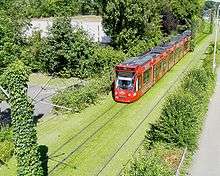
This meant that the Western Railway Depot received a railway link for the first time. The depots at Komturstraße and Urachstraße had less importance. The northern depot was demolished in 2007, while the southern depot now houses a museum.
The link to the newly developed district of Rieselfeld was established in 1997. On this 1.3 kilometre section, the route runs on a ridged track in the middle of Rieselfeldallee and serves three stops at Geschwister-Scholl-Platz, Maria-von-Rudloff-Platz and Bollerstaudenstraße. The terminal loop at Rieselfeld turns around a residential building, the so-called "Tram-Turm".
On 3 June 2002, the VAG introduced a relief Line 8 from Munzinger Straße to Stadthalle in a cycle of 15 minutes, which was discontinued after just two months on 27 July 2002.
After 40 years, the Haslach district had a tram network when Line 7 was first opened between Am Lindenwäldle and Pressehaus in October 2002. The route follows the vineyard route and runs to the north of Opfinger Straße to the crossing of the freight railway, then follows the course of Carl-Kistner-Straße and serves Haslach Bad, Scherrerplatz and Dorfbrunnen in the middle of Haslach. There was controversy when the link connecting Pressehaus and the Innenstadt were taking place. Although the majority voted for the route to lead to Stadttheater via Kronenstraße in 1997, the municipal council voted for a different route via Basler Straße to Johanniskirche.[37] Finally, in 2004, the entire route between Am Lindenwäldle and Johanniskirche was operational and formed as Line 5. The costs for this project amount to about 30 million Euros. Later, it was decided to implement the first-named routed as part of the "Stadtbahn Rotteckring".
The district of Vauban, built on the site of a former barracks in 1998, also had access to the tram network in 2006 after three years of construction.[38][39] The cost amounted to 18 million euros instead of the originally estimated 30 million.[40] The 2.5 kilometre long section branches off from the route towards Haslach to Merzhauser Straßer after the stop at Heinrich-von-Stephan-Straße and runs mostly along a leafy road towards Merzhauser Straße. At Paula-Modersohn-Platz, the route turns into Vaubanallee and runs mainly northwards until its final stop at Innsbrucker Straße.
Expansion program "Stadtbahn 2020" and night trams
Between February 2009 and November 2010, the section of the track was completely renovated by Habsburger Straße. The tram had on the most part its own green body. In addition, three stops at Tennenbacher Straße, Hauptstraße and Okenstraße were adapted to operate without barriers.[41] The section between Maria-Hilf-Kirche and Musikhochschule along Schwarzwaldstraße were modernised in 2011.[42]
On 15 March 2014, the 1.8 kilometre stretch was opened from Reutebachgasse to the centre of Zähringen at Gundelfinger Straße after three years of construction. Part of this project was also the construction of the stop at Reutebachgasse about 50 metres to the north. The route follows the course of Zähringer Straße, crosses the freight railway and runs on its own line west of Gundelfinger Straße to the southern outskirts of Gundelfingen. Part of the terminal loop is located at the Gundelfinger boundary, so trams leave the region of Freiburg here. The cost of this construction project amassed 24.5 million euros.[43]
From the beginning of June to the end of October 2014, tracks at the junction of Bertoldsbrunnen were renovated after the points had broken out.[44] During this large project, all lines had to be relocated to the edge of the inner city (Siegesdenkmal, Stadttheater, Holzmark and the Schwabentor loop). One operational feature during this period was the GT8N-operated Line 1 heading east, because a provisional depot had to be erected at Möschlschleife due to the lack of a track connection to the depot.[45]
When a change of timetable on 14 December 2014 took place, the city council decided to reduce the noise in the inner city by means of a continuous night service in 30-minute cycles on Saturday, Sunday and pre-selected holidays, except for the sections between Johanniskirche and Günterstal, and Technisches Rathaus and Hornusstraße.[46] This cost around 550,000 euro a year and according to VAG has been seen as a positive move. By counting the number of passengers on the night services in November 2014, it was reported that a high four-digit number of passengers use the service a night.[47]
The last expansion was the partial commissioning of the "Stadtbahnmesse", which started on 14 June 2013[48] to Technische Fakultät on 11 December 2015.[49] The 1.5 kilometre long stretch crosses the network at Robert-Koch-Straße and continues via Breisacher Straßer and Berliner Allee to the provisional terminus just to the north of the Freiburg-Colmar railway link. The new Line 4, was initially marked as "MESSE" (in uppercase lettering). Since February 2016, the normal spelling of "Messe" has been used.
Operations
Overview
The five tram lines, all of which are cross-city routes, serve a total of 73 stops. The average distance between stops in 2012 was 456 metres.[50] With the stop at Stadthalle (formerly known as Messplatz) in Mösleschleife, which is only stopped at by the Oldtimerlinie 7, as wall as the stop at Schwabentorschleife, which is only used in case of operational disturbances in the inner city, means there is a total of 75 stops in use. Trams run between 5am and 0:30am Monday to Friday, and non-stop at weekends. The line length is 32.3 kilometres, the cumulative line length is 40 kilometres.[51] VAG operates a total of 24 substations with an installed total transformer capacity of 33.75 megavoltamperes (MVA).[52]
Because of reconstruction work at the northern part of Kaiser-Joseph-Straße and kink at Siegesdenkmal, lines 2 and 4 have been interrupted between Bertoldsbrunnen and Siegesdenkmal since 6 March 2017. This is likely to run until December 2017.[53]
| Line | Route | Stops | Cycle | Length | Journey time | Mode | Trams used | Courses at one time | Course numbers |
|---|---|---|---|---|---|---|---|---|---|
| 1 | Littenweiler, Laßbergstraße[54] -
Landwasser, Mossweiher |
22 | 6 mins | 9.9 km | 29mins | Unidirectional | GT8K, GT8N,
Combino, Urbos |
16 | 1-01 - 1-16 |
| 2/4 | Günterstal, Dorfstraße -
Messe, Technische Fakultät |
18 | 10 mins | 7.2 km | 25mins | Bidirectional | GT8Z | 7 | 2-43 - 2-49 |
| 3 | Vauban, Innsbrucker Straße -
Haid, Munzinger Straße |
21 | 7.5 mins | 9.2 km | 32mins | Unidirectional | GT8K, GT8N,
GT8Z, Combino, Urbos |
11 | 3-30 - 3-39 |
| 4 | Siegesdenkmal -
Zähringen, Gindelfinger Straße |
10 | 7.5 mins | 4.2 km | 13mins | Bidirectional | GT8Z, Combino,
Urbos |
6 | 4-50 - 4-55 |
| 5 | Rieselfeld, Bollerstaudenstraße -
Zähringen, Gundelfinger Straße/Hornusstraße |
30 | 7.5 mins | 12.4 km | 43/45 mins | Unidirectional | GT8K, GT8N,
GT8Z, Combino, Urbos |
15 | 5-60 - 5-72 |
- Line 2 from Günterstal changes at Bertoldsbrunnen to Line 4 towards Messe (and vice versa)
- Combino and Urbos cannot be used on lines 2 and 4 because they are not suitable for the route to Günterstal.
- As a rule, the GT8Z can not be used on line 1 because its capacity is too low as this is the busiest line on the network.
- For all SC Freiburg's home games to Schwarzwald Stadion, additional trams are used on line 1 and run between Bissierstraße and Littenweiler. These fast services are marked with a football as a symbol instead of a line number. They travel between Betroldsbrunnen and Römerhof without stopping, from where the ground is accessible by foot in five minutes. After the match, the first five trams run without stopping to Oberlinden.[55]
- In the evenings, from 9pm to 10:16pm, lines 1, 3, 4 and 5 meet in both directions for minutes 01, 16, 31 and 46 to form a circular enclose at Bertoldsbrunnen. After this time, they wait until 01 and 31.
- On lines 1, 3, 4 and the Rieselfeld-Bertoldsbrunnen section of line 5, a night service leaves every 30 minutes from Bertoldsbrunnen between 1am and 4:30 on Saturday, Sunday and on selected bank holidays.[56] Günterstal and other inner- and non-urban dstinations are connected to the night service in the form of taxis and buses.[57]
- Trams heading to and from VAG-Zentrum are marked with a red slash instead of a line number. A special feature of Freiburg are the long reverse travels of the trams carried out without passengers with the help of a rear-drivers seat. This procedure is used on sections VAG-Zentrum to Runzmattenweg (Line 1), Heinrich-von-Stefan-Straße to Vauban, Innsbrucker Straße (Line 3) and Am Lindenwäldle to Rieselfeld, Bollerstaudenweg (Line 5).[58]
- With the exception of Bertoldsbrunnen, Eichstetter Straße, Komturplatz, Klosterplatz and Oberlinden, all stations have platforms with barrier-free access to low-floor vehicles.
- Course numbers are not stated by lines (for example, Line 3, Course 1) but by a three-digit number range. Originally, it was a two-digit range.[59]
- Apart from the terminus stops, all stops along Freiburg's tram network are request stops.
Tariff
Trams have been a part of the Regio-Verkehrsverbund Freiburg (RVF) since 1994. The entire network is located within tariff zone A, which means that for a tram ride, the tariff is level 1. The model of success is the so-called "Regio-Karte". It is readily available and is valid throughout the network. Single tickets cost 2.30 euros, for children up to 14 years of age, 1.40 euros. In addition, a day ticket (Regio 24) and various other tickets are also available. Bikes are not permitted in any tram on the network.[60]
There are ticket machines in all carriages and at important stops. Passengers wanting to buy tickets from the driver is no longer possible and has been the case since the start of 2016.[61]
Development of passenger numbers
| 1902 | 1919 | 1923 | 1936 | 1984 | 1985 | 2000 | 2013 |
|---|---|---|---|---|---|---|---|
| 3,250,000 | 14,600,000 | 800,000 | 9,400,000 | 29,000,000* | 33.800,000* | 65,000,000* | 63,400,000* |
* = Passenger numbers from 1984, 1985 and 2000 also include buses and rail replacement services, as there is no explicit data for these years.
Route timeline
The following table shows all openings and closures in passenger-oriented trams. Temporary routes are not included.
| Route | Opened | Closed |
|---|---|---|
| Günterstal - Bertoldsbrunnen - Rennweg | 14 October 1901 | |
| Hauptbahnhof - Bertoldsbrunnen - Alter Messplatz | 2 December 1901 | |
| Schwabentorbrücke - Alter Wiehrebahnhof - Lorettostraße | 2 December 1901 | |
| Hauptbahnhof - Lehener Straße | 1902 | |
| Alter Messplatz - Musikhochschule | 1905 | |
| Lehener Straße - Friedrich-Ebert-Platz - Güterbahnhof | 1908 | |
| Rennweg - Okenstraße | 1908 | |
| Siegesdenkmal - Hauptbahnhof | 17 June 1909 | |
| Siegesdenkmal - Stühlinger Kirchplatz | 1 September 1909 | |
| Okenstraße - Komturplatz - Reutebachgasse | 10 March 1910 | |
| Lorettostraße - Goethestraße | December 1910 | |
| Stühlinger Kirchplatz - Scherrerplatz | October 1913 | |
| Siegesdenkmal - Immentalstraße | 1 July 1914 | |
| Musikhochschule - Römerhof - Bahnhof Littenweiler | 7 March 1925 | |
| Kaiserstuhlstraße - Güterbahnhof | 1928 | |
| Kaiserstuhlstraße - Komturplatz | 1928 | |
| Lorettostraße - Goethestraße | 15 October 1931 | |
| Immentalstraße - Herdern Kirche | 1 July 1951 | |
| Schwabentorbrücke - Alter Wiehrebahnhof - Lorettostraße | 1959 | |
| Scherrerplatz - Wilhelmerstaße and Hauptbahnhof -
Siegesdenkmal - Herdern Kirche |
31 December 1961 | |
| Laßbergstraße - Bahnhof Littenweiler | 20 December 1962 | |
| Stadttheater - Rathaus im Stühlinger - Paduaallee | 9 December 1983 | |
| Runzmattenweg - Bissierstraße | 9 December 1983 | |
| Paduaallee - Moosweiher | 14 June 1985 | |
| Rathaus im Stühlinger - Friedrich-Ebert-Platz | 27 September 1986 | |
| Hauptbahnhof - Hugstetter Straße - Friedrich-Ebert-Platz | 27 September 1986 | |
| Bissierstraße - Am Lindenwäldle - Munzinger Straße | 26 March 1994 | |
| Am Lindenwäldle - Bollerstaudenstraße | 14 September 1997 | |
| Am Lindenwäldle - Pressehaus | 12 October 2002 | |
| Pressehaus - Johanneskirche | 20 March 2004 | |
| Heinrich-von-Stefan-Straße - Innsbrucker Straße | 29 April 2006 | |
| Reutebachgasse - Gundelfinger Straße | 15 March 2014 | |
| Robert-Koch-Straße - Technische Fakultät | 11 December 2015 |
Line timeline
Lines were originally given letters before they were allocated Arabic numerals in 1909. Each line had its own destinations, which differed in colour. The official introduction of colour-coded lines took place in the Summer of 1921. However, these were not displayed at all times on trams, but were only partly used for internal distinction or listed on the transit map. As a special feature, the VAG introduced a line reform in 1983, when the colours of the lines were changed and coloured roll signs were introduced to display the line number. This was also only the case in a few other German cities.
Daily usage
| Line | Route | From | Until |
|---|---|---|---|
| A | Hauptstraße (formerly: Rennweg) – Siegesdenkmal – Bertoldsbrunnen – Lorettostraße | 14 October 1901 | 1908 |
| Okenstraße (formerly: Roßgäßle) – Siegesdenkmal – Bertoldsbrunnen – Lorettostraße | 1908 | 16 June 1909 | |
| 1 | 17 June 1909 | 14 April 1921 | |
| 15 April 1921 | 27 November 19442) | ||
| 13 March 1946 | 19 December 1962 | ||
| Hornusstraße – Siegesdenkmal – Bertoldsbrunnen – Lorettostraße | 20 December 1962 | 8 December 1983 | |
| 1 | Laßbergstraße – Schwabentorbrücke – Bertoldsbrunnen – Hauptbahnhof – Runzmattenweg – Paduaallee | 9 December 1983 | 13 June 1985 |
| Laßbergstraße – Schwabentorbrücke – Bertoldsbrunnen – Hauptbahnhof – Runzmattenweg – Moosweiher | 14 June 1985 | today | |
| D | Hauptstraße (formally: Rennweg) – Siegesdenkmal – Bertoldsbrunnen – Dorfstraße | 14 October 1901 | 1908 |
| Okenstraße (formally: Roßgäßle) – Siegesdenkmal – Bertoldsbrunnen – Dorfstraße | 1908 | 16 June 1909 | |
| 2 | 17 June 1909 | 9 March 1910 | |
| Reutebachgasse – Siegesdenkmal – Bertoldsbrunnen – Dorfstraße | 10 March 1910 | 14 April 1921 | |
| 15 April 1921 | 27 November 19442) | ||
| Holzmarkt – Dorfstraße | 28 November 1944 | 15 May 1945 | |
| 25 May 1945 | 3 October 1945 | ||
| Reutebachgasse – Komturplatz | 25 June 1945 | 3 October 1945 | |
| Reutebachgasse – Siegesdenkmal – Bertoldsbrunnen – Dorfstraße | 4 October 1945 | September 1996 | |
| 29 April 2006 | 14 March 2014 | ||
| Gundelfinger Straße – Siegesdenkmal – Bertoldsbrunnen – Dorfstraße | 15 March 2014 | 10 December 2015 | |
| Hornusstraße – Siegesdenkmal – Bertoldsbrunnen – Dorfstraße | 11 December 2015 | today | |
| C | Hauptbahnhof – Bertoldsbrunnen – Schwabentorbrücke – Alter Messplatz (formerly: Bleicheweg) | 2 December 1901 | 1902 |
| Lehener Straße – Hauptbahnhof – Bertoldsbrunnen – Schwabentorbrücke – Alter Messplatz (formerly: Bleicheweg) | 1902 | 1905 | |
| Lehener Straße – Hauptbahnhof – Bertoldsbrunnen – Schwabentorbrücke – Musikhochschule (formerly: Waldsee) | 1905 | 1908 | |
| Güterbahnhof – Hauptbahnhof – Bertoldsbrunnen – Schwabentorbrücke – Musikhochschule (formerly: Waldsee) | 1908 | 16 June 1909 | |
| 3 | 17 June 1909 | 14 April 1921 | |
| 3 | Güterbahnhof – Hauptbahnhof – Bertoldsbrunnen – Alter Messplatz (formerly: Bleichestraße) | 15 April 1921 | 7 March 1925 |
| Güterbahnhof – Hauptbahnhof – Bertoldsbrunnen – Schwabentorbrücke – Musikhochschule (formerly: Waldsee) | 8 March 1925 | 1928 | |
| Friedrich-Ebert-Platz (formerly: Hohenzollernplatz) – Hauptbahnhof – Bertoldsbrunnen – Schwabentorbrücke – Musikhochschule (formerly: Waldsee) | 1928 | 1938 | |
| Friedrich-Ebert-Platz (formerly: Hohenzollernplatz) – Hauptbahnhof – Bertoldsbrunnen – Schwabentorbrücke – Römerhof (formerly: Wendelinstraße) | 1938 | 27 November 19442) | |
| 3 | 13 March 1946 | 1953–1957 | |
| Hauptfriedhof (formerly: Friedhof) – Hauptbahnhof – Bertoldsbrunnen – Schwabentorbrücke – Römerhof | 1953-1957 | 19 December 1962 | |
| Hauptfriedhof (formerly: Friedhof) – Hauptbahnhof – Bertoldsbrunnen – Schwabentorbrücke – Laßbergstraße | 20 December 1962 | ? | |
| Hornusstraße – Hauptbahnhof – Bertoldsbrunnen – Schwabentorbrücke – Laßbergstraße | ? | 8 December 1983 | |
| 3 | Circular route: Hornusstraße – Hauptbahnhof – Bertoldsbrunnen – Siegesdenkmal – Hornusstraße (– Reutebachgasse)1) | 9 December 1983 | 26 September 1986 |
| Circular route: Hornusstraße – Robert-Koch-Straße – Hauptbahnhof – Bertoldsbrunnen – Siegesdenkmal – Hornusstraße (– Reutebachgasse)1) | 27 September 1986 | September 1996 | |
| Oldtimerlinie3): Paduaallee – Runzmattenweg – Hauptbahnhof – Bertoldsbrunnen – Schwabentorbrücke – Musikhochschule (formerly: Stadthalle) | September 1996 | 1 October 2005 | |
| Innsbrucker Straße – Heinrich-von-Stephan-Straße – Bertoldsbrunnen – Hauptbahnhof – Runzmattenweg – Munzinger Straße | 29 April 2006 | today | |
| B | Hauptbahnhof – Bertoldsbrunnen – Schwabentorbrücke – Alter Wiehrebahnhof (formerly: Bahnhof Wiehre) – Lorettostraße | 2 December 1901 | 1902 |
| Lehener Straße – Hauptbahnhof – Bertoldsbrunnen – Schwabentorbrücke – Alter Wiehrebahnhof (formerly: Bahnhof Wiehre) – Lorettostraße | 1902 | 16 June 1909 | |
| 4 | 17 June 1909 | December 1910 | |
| Lehener Straße – Hauptbahnhof – Bertoldsbrunnen – Schwabentorbrücke – Alter Wiehrebahnhof (formerly: Bahnhof Wiehre) – Goethestraße | December 1910 | 14 April 1921 | |
| 4 | Lehener Straße – Hauptbahnhof – Bertoldsbrunnen – Schwabentorbrücke – Musikhochschule (formerly: Waldsee/Mösle) | 15 April 1921 | 6 March 1925 |
| Lehener Straße – Hauptbahnhof – Bertoldsbrunnen – Schwabentorbrücke – Bahnhof Littenweiler | 7 March 1925 | 1928 | |
| Komturplatz – Hauptbahnhof – Bertoldsbrunnen – Schwabentorbrücke – Bahnhof Littenweiler | 1928 | 27 November 19442) | |
| Oberlinden – Schwabentorbrücke – Bahnhof Littenweiler | 28 November 1944 | 15 May 1945 | |
| 25 May 1945 | 12 March 1946 | ||
| Komturplatz – Friedrich-Ebert-Platz (formerly: Hohenzollernplatz) | 25 June 1945 | 12 March 1946 | |
| Komturplatz – Hauptbahnhof – Bertoldsbrunnen – Schwabentorbrücke – Bahnhof Littenweiler | 13 March 1946 | 19 December 1962 | |
| Hornusstraße – Hauptbahnhof – Bertoldsbrunnen – Schwabentorbrücke – Lassbergstraße | 20 December 1962 | 8 December 1983 | |
| 4 | Hornusstraße – Hauptbahnhof – Bertoldsbrunnen – Schwabentorbrücke – Lorettostraße (– Dorfstraße)1) | 9 December 1983 | 26 September 1986 |
| Hornusstraße – Robert-Koch-Straße – Hauptbahnhof – Bertoldsbrunnen – Schwabentorbrücke – Lorettostraße (– Dorfstraße)1) | 27 September 1986 | September 1996 | |
| Hornusstraße – Robert-Koch-Straße – Hauptbahnhof – Bertoldsbrunnen – Dorfstraße | September 1996 | 28 April 2006 | |
| 4 | Gundelfinger Straße – Siegesdenkmal – Bertoldsbrunnen – Hauptbahnhof – Robert-Koch-Straße – Technische Fakultät | 11 Dezember 2015 | today |
| 5 | Siegesdenkmal – Hauptbahnhof | 17 June 1909 | 31 August 1909 |
| Siegesdenkmal – Hauptbahnhof – Eschholzstraße (formerly: Stühlinger Kirchplatz) | 1 September 1909 | October 1913 | |
| Siegesdenkmal – Hauptbahnhof – Eschholzstraße (formerly: Stühlinger Kirchplatz) – Scherrerplatz | October 1913 | 22 November 1919 | |
| Immentalstraße – Siegesdenkmal – Hauptbahnhof – Eschholzstraße (formerly: Stühlinger Kirchplatz) – Scherrerplatz | 23 November 1919 | 14 April 1921 | |
| 15 April 1921 | 27 November 19442) | ||
| Eschholzstraße (formerly: Stühlinger Kirchplatz) – Scherrerplatz | 1 September 1946 | 14 April 1949 | |
| Immentalstraße – Siegesdenkmal | 18 October 1946 | 14 April 1949 | |
| Immentalstraße – Siegesdenkmal – Hauptbahnhof – Eschholzstraße (formerly: Stühlinger Kirchplatz) – Scherrerplatz | 15 April 1949 | 30 June 1951 | |
| Herdern Kirche – Siegesdenkmal – Hauptbahnhof – Eschholzstraße (formerly: Stühlinger Kirchplatz) – Scherrerplatz | 1 July 1951[62] | 31 December 1961 | |
| Bissierstraße – Runzmattenweg – Hauptbahnhof – Bertoldsbrunnen – Siegesdenkmal – Hornusstraße (– Reutebachgasse)1) | 9 December 1983 | 25 March 1994 | |
| Munzinger Straße – Runzmattenweg – Hauptbahnhof – Bertoldsbrunnen – Siegesdenkmal – Hornusstraße (– Reutebachgasse)1) | 26 March 1994 | 19 March 2004 | |
| Bollerstaudenstraße – Scherrerplatz – Hauptbahnhof – Bertoldsbrunnen – Runzmattenweg – Bissierstraße | 20 March 2004 | 28 April 2006 | |
| Bollerstaudenstraße – Scherrerplatz – Bertoldsbrunnen – Hauptbahnhof – Robert-Koch-Straße – Hornusstraße | 29 April 2006 | 14 March 2014 | |
| Bollerstaudenstraße – Scherrerplatz – Bertoldsbrunnen – Hauptbahnhof – Robert-Koch-Straße – Hornusstraße (– Gundelfinger Straße)1) | 15 March 2014 | today | |
| 64) | Immentalstraße – Siegesdenkmal | 1 July 1914 | 22 November 1919 |
| Schwabentorbrücke – Alter Wiehrebahnhof (formerly: Bahnhof Wiehre) – Goethestraße | 15 April 1921 | 16 October 1922 | |
| 22 December 1924 | 15 October 1931 | ||
| Schwabentorbrücke – Alter Wiehrebahnhof (formerly: Bahnhof Wiehre) | 16 October 1931 | 9 November 1934 | |
| Schwabentorbrücke – Alter Wiehrebahnhof – Lorettostraße | 1940 | 1943 | |
| 1 September 1946 | 19 November 1950 | ||
| 6 | Bollerstaudenstraße – Runzmattenweg – Hauptbahnhof – Bertoldsbrunnen – Siegesdenkmal – Reutebachgasse | 14 September 1997 | 19 March 2004 |
| Munzinger Straße – Runzmattenweg – Hauptbahnhof – Bertoldsbrunnen – Siegesdenkmal – Reutebachgasse | 20 March 2004 | 28 April 2006 | |
| 7 | Munzinger Straße – Scherrerplatz – Pressehaus | 12 October 2002[63] | 19 March 2004 |
| 7 | Oldtimerlinie3): Musikhochschule – Runzmattenweg – Hauptbahnhof – Bertoldsbrunnen – Schwabentorbrücke – Paduaallee | 6 May 2006 | today |
| 8 | Munzinger Straße – Runzmattenweg – Hauptbahnhof – Bertoldsbrunnen – Schwabentorbrücke – Musikhochschule (formerly: Stadthalle) | 3 June 2002 | 27 July 2002 |
1) = Only for professional traffic
2) = Bombing of Freiburg on 27 November 1944
3) = Only on the first Saturday between months May and September operated by the Freunde der Freiburger Straßenbahn (Friends of Freiburg's Tramways).
4) = Destination board was divided diagonally. Upper left white and lower right red.
Night service
The night service "Safer Traffic" was originally served by buses from 1996, but have largely been tram-operated since 14 December 2014.[64]
| Line | Route | From | Until |
|---|---|---|---|
| 1 | Laßbergstraße – Schwabentorbrücke – Bertoldsbrunnen – Hauptbahnhof – Runzmattenweg – Moosweiher | 14 December 2014 | today |
| 2/5 | Gundelfinger Straße – Siegesdenkmal – Bertoldsbrunnen – Scherrerplatz – Bollerstaudenstraße | 14 December 2014 | 6 December 2015 |
| 3 | Innsbrucker Straße – Heinrich-von-Stephan-Straße – Bertoldsbrunnen – Hauptbahnhof – Runzmattenweg – Munzinger Straße | 14 December 2014 | today |
| 4 | Gundelfinger Straße – Siegesdenkmal – Bertoldsbrunnen – Hauptbahnhof – Robert-Koch-Straße – Technische Fakultät | 11 December 2015 | today |
| 5 | Bollerstaudenstraße – Scherrerplatz – Bertoldsbrunnen | 11 December 2015 | today |
Trams
Currently used trams
_GT8K_210_an_der_Hornusstra%C3%9Fe.jpg)
GT8K
In 1981, after a good experience with the GT8 Geamatic, which was delivered in 1971, a further series of ten vehicles were commissioned with service numbers 205-214 on the route to Landwasser. The high-floor uni-directional trams were delivered with the white and red Freiburg livery and have two front headlights. The seats are arranged transversely in the diagram 2+1 instead of the mechanical stepped cruise control of earlier trams. The second series used for the first time a direct current controller, which was operated via set point transmitter. It allows a largely jerka-free acceleration and deceleration. Compared to the first series, which had scissor pantographs , the second series had single-arm pantographs.
Tram 205 is now used as an historic tram, tram 207 was scrapped in 2007 and trams 208 and 209 were sold to the Ulm tram network in 2008, where they were merged into a two-wheeled tram using number 17.[65]
Since 2006, the use of these trams are usually limited to the morning rush hour or as an additional service to SC Freiburg's home games. From 2012 to 2017, trams 206 and 210-214 were again put into use due to the renovation of the GT8Zs. For this purpose, tram 206, which had not been used for years, had to be reactivated and was the first tram to have an LED display, whilst the remaining vehicles were renovated in March 2013. Due to the introduction of the second Urbos series at the start of 2017, tram 206 was retired once more.[66] The remaining five GT8Ks (210-214) will only operate on Lines 1 (during peak times), 3 and 5, as well as for stadium transportation from Mondays to Fridays.[67]
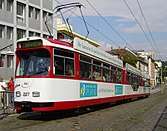
GT8N
In 1990, Duewag delivered another series of eleven developed GT8s for a unit price of 2.75 million Deutsche Mark each. Unlike its predecessors, the GT8N 221-231 have a low-floor middle section, which allows a barrier-free entry. Firstly, the GT8N were used mainly only Line 1, where they replaced the GT4 procured from Stuttgart.[67]
In contrast to the GT8K, the GT8N were also equipped with scissor pantographs. In 2011, all trams had a matrix display installed. The trams were modernised by the Czech company Cegelec, who replaced the obsolete thyristor technology with relatively new insulated-gate bipolar transistors (IGBT) technology, which was a further development to the thyristor.[68] The aim of this measure was to extend the service life of the vehicles, to reduce maintenance costs and electricity consumption and to improve the availability of spare parts. The modernisation process was completed in 2011,
In recent years, the GT8N's usage has been shifted to lines 3 and 5. The eleven trams are generally only used on weekdays.
GT8Z
At the beginning of the 1990s, Freiburg was looking for modern low-floor trams. For this reason, it was a good idea to order a series of 26 GT8Y (241-266) with a low-floor share of 48 percent in 1994 to start the Haid route. The purchase price was 4 million Deutsche Mark each. At the same time, the last remaining GT4s were decommissioned.[67] The bi-directional trams could be used across all lines. Currently, they are exclusively used on lines 2/4 as well as 3, 4 and 5.
For more than 20 years of operation, there were some instances of rusting, but this has been eradicated since they were modernised in 2012.[67] Outdated transistors were replaced at the Siemens Test Centre at Wildenrath. In addition, Cegelec replaced the electronics (including two new liquid crystal displays in the centre cabin) and replacing the seat cushions.[69] Trams 241-245, 247, 250-252, 258, 259, 262 and 264 have been completely renovated. In early 2017, 248, 249, 260 and 266 were being modernised and therefore were not in use. After a test phase in 2013, during which time operation on line 3 was limited, trams that had been modernised were running on lines 2 and 5 from March 2014.

Combino Basic
When the route to Rieselfeld and Haslach had been opened, the need for trams continued to rise. For this reason, a series of nine trams was ordered from Duewag's successor company Siemens. The first seven-part bi-directional trams were delivered in 1999.[67]
Because of serious design deficiencies, all Combinos had to be withdrawn from circulation in 2004. Some screws had become loose and had to be resolved, causing considerably restricted operation. The reason behind this, which occurred worldwide, was a false calculation of the body. Erroneous values were calculated on high-floored units. Tram 272 was artificially aged in order to gain more insights into the strength of the bodies.[70] After these attempts, this tram was no longer operation and had to be withdrawn from service. The refurbishment of the Combinos continued until 2007, but now 271 and 273-279 are fully operational once more.
Combino Advanced
The Combino Advanced was built by Siemens on its own accord and were initially made available free of charge to VAG.[67] In this series, which was delivered in 2004 and 2006 with operating numbers 281-290, the bodies were reinforced from the outset in order to avoid similar problems. Originally, only nine were planned, while car 290 was delivered as a replacement for the scrapped 272 Combino.
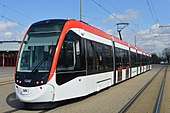
The seven-part bi-directional trams differed from their predecessors by having a rounder-shaped head. The entire passenger section was air-conditioned. In the Combino Basics, this was only in the cab.
Urbos
On 4 February 2013, the Spanish company CAF was awarded the contract to produce twelve 43 metre long seven-sectioned bi-directional trams.[71][72][73] The purchase price was 36 million euros. The first tram was numbered 302 and arrived on 17 March 2015.[74] Five other trams from the first series, numbers 301, 303-306 were delivered during the summer of 2015.[75] Regular deployment began on 22 July 2015 after trail and training trips.[76] The new trams serve lines 1, 3, 5 and on the northern branch of line 4. Delivery of the second series, numbers 307 to 312 was between February and July 2017.[77][78] Since July 2017, ten Urbos (301-310) are currently being used.
Future trams
The VAG is currently preparing a new supply of trams to be commissioned during 2020 and 2024, which are intended to replace 16 trams (GT8N and GT8K).[79]
Former and museum trams
Railcars
The following rail cars were procured for trams, which are currently no longer used for regular services. Until 1959, the company only had access to two-axle or short four-axle maximum rail cars, and from this year onwards, only articulated trams. On the other hand, large-scale units were never used in Freiburg. All previously cancelled units were high-floored.
The remaining trams are partly used on the Oldtimerlinie 7 operated by Freunde der Freiburger Straßenbahn. In the months of May to September, the route between Paduaallee and Stadthalle took place on the first Saturday of the month, and stops at all intermediate stations could be used free of charge.[80] Historic trams are stationed in the former southern depot at Urachstraße.
| Photo | Number | Unit | Manufacturer | Type | Kind | Year of manufacture | In service until | Notes |
|---|---|---|---|---|---|---|---|---|
| 1–27 | 27 | HAWA | Two-axle | Bi-directional | 1901 | 1954 | Number 2 kept as a museum tram | |
| 28–30 | 3 | Waggonfabrik Rastatt | Two-axle | Bi-directional | 1907 | 1960 | ||
| 31–40 | 10 | MAN | Two-axle | Bi-directional | 1909 | 1962 | Number 38 work tram, now kept as a museum tram | |
_001.jpg) |
41–47 | 7 | MAN | Two-axle | Bi-directional | 1914 | 1966 | Number 42 was handed over to the Museum of Automotive Engineering at Marxzell in 1972,
Number 42 kept as a museum tram |
| 47–52 | 6 | Waggonfabrik Fuchs | Maximum railcar | Bi-directional | 1927 | 1968 | ||
| 53–61 | 9 | Waggonfabrik Rastatt | Maximum railcar | Bi-directional | 1927–1929 | 1978 | Number 56 kept as a museum tram | |
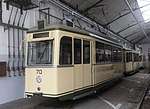 |
61–74 | 14 | Waggonfabrik Rastatt | Multi-purpose | Bi-directional | 1951–1953 | 1972 | Number 61 in second usaage, first Freiburg tram with steel construction
Number 70 kept as a museum tram Number 72 kept as tram 406 |
| 100–102 | 3 | Waggonfabrik Rastatt | Sputnik | Uni-directional | 1959 | 1993 | First articulated tram in Freiburg, named after the satelitte of the same name
100 (1967-1994 as 103), was reused as a rehabilitation tram and since 2006 museum tram 101 and 102 were scrapped in 1995. | |
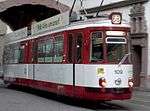 |
104–122 | 19 | 104–114: Maschinenfabrik Esslingen
115–122: Waggonfabrik Rastatt |
GT4 | Bi-directional | 1962–1968 | 1994 | Sold to the tramway of Brandenburg an der Havel, tramway of Halberstadt and Nordhausen after decommissioning
107 in reprocessing 109 as a museum car 121 as a party car |
 |
151–160 | 10 | Maschinenfabrik Esslingen | GT4 | Uni-directional | 1964 | 1990 | Taken from Stuttgart in 1985
After decommissioning, given to Halle tramway 151-157 from there to Iasi 158-160 scrapped |
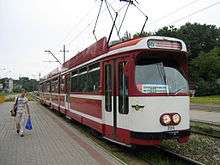 |
201–204 | 4 | Duewag | GT8 | Uni-directional | 1972 | 2001 | With Geamtic control
Used in Lodz from 2006 to 2012, later scrapped or used for spare parts |
Sidecars
| Number | Unit | Manufacturer | Year of construction | Year of decomisisoning | Notes | |
|---|---|---|---|---|---|---|
| 28–31 | 4 | HAWA | 1901 | 1918–1921 | 29-31 open saloon wagons, produced for use in Günterstal, renumbered in 1909 to 101-104 | |
| 32–34 | 3 | Waggonfabrik Rastatt | 1903 | 1944 | Procured for use in Günterstal, renumbered 105-107 in 1909, trams were given new bodies in 1954 | |
| 38–40 | 3 | Waggonfabrik Rastatt | 1907 | 1968 | Procured for use in Günterstal, renumbered 108-111 in 1909, trams were given superstructures in 1950 | |
| 111–120 | 10 | MAN | 1909 | 1971 | Matching railcars 31-40, used on lines 2 and 4. Trams had new constructions in 1949 (new numbers 116-125) | |
| 126–134 | 9 | Rathgeber | 1950 | 1978–1981 | Trailers for the multi-purpose trams | |
| 135–143 | 9 | Waggonfabrik Rastatt | 1952–1953 | 1981 | Trailers for the multi-purpose trams, 135 and 142 kept as museum trams | |
| 105–111 | 7 | Eigenbau | 1954 | 1960 | Modified motor trams from series 1 to 27 (3, 4, 6, 10, 18, 25 and 26), year of manufacture originally 1901 |
Departmental vehicles
Originally, the departmental trams were numbered up from 200.[81] Since 1971, they were numbered from 400 since the GT8 at the time was numbered 200.
| Number | Type | Manufacturer | Year of construction | Notes |
|---|---|---|---|---|
| 201 | Water Tram | Helmers | 1901 | In use until 1950, passed on to the Middle Baden Train Network |
| 201II | Auxiliary Equipment Tram | HAWA | 1901, Renovated 1950 | Originated from railcar 27, in use until 196 |
| 202 | Water Tram | Helmers | 1909 | In use until 1950 |
| 203 | Grinder Tram | Schörling | 1914 | From 1971, new number 414, in use until 1982, kept as a museum tram |
| 204 | Salt Tram | Helmers | 1901 | With snowplow, in use until 1968 |
| 205 | Salt Tram | Eigenbau | 1909 | In use until 1971, last number 415 |
| 207 | ? | HAWA | 1901, Renovated 1954 | Former railcar 13, in use until 1961 |
| 208 | ? | HAWA | 1901, Renovated 1954 | Former railcar 14, in use until 1962 |
| 209 | ? | HAWA | 1901, Renovated 1954 | Former railcar 15, in use until 1962 |
| 209II | Transportation Tram | ? | 1962 | From 1971, new number 416 |
| 210 | ? | HAWA | 1901, Renovated 1954 | Former railcar 21, in use until 1962 |
| 210II | Transportation Tram | ? | 1962 | From 1971, new number 417 |
| 211 | ? | HAWA | 1901, Renovated 1954 | Former railcar 12, in use until 1961 |
| 212 | ? | HAWA | 1901, Renovated 1954 | Former railcar 17, in use until 19XX |
| 401 | Driving School Tram | Waggonfabrik Rastatt | 1951, Renovated 1970 | Former railcar 65, decommissioned |
| 402 | Catenary Tram | Waggonfabrik Rastatt | 1951, Renovated 1970 | Former railcar 70, rebuilt to original condition in 2016, planned use as a museum wagon |
| 403 | Workshop Tram | Waggonfabrik Rastatt | 1951, Renovated 1971 | Former multi-purpose tram, decommissioned |
| 404 | Workshop Tram | Waggonfabrik Rastatt | 1951, Renovated 1971 | Former multi-purpose tram, decommissioned |
| 405 | Workshop Tram/
Grinder Tram |
Waggonfabrik Rastatt | 1951, Renovated 1979 | Former railcar 66, initially workshop tram
From 1982, a grinder tram, sold in 2012 to Halberstadt |
| 406 | Workshop Tram | Waggonfabrik Rastatt | 1951, Renovated 1971 | Former multi-purpose tram, given to the Bergish Tram Museum in 2002 |
| 406II | Track Grinding Tram SF 50 | Windhoff | 2012 | Four grinding wheels, still in use today |
| 407 | Workshop Tram | Waggonfabrik Rastatt | 1951, Renovated 1971 | Former multi-purpose tram, decommissioned |
| 407II | Maintenance Klv53Cl | Schöma | 1982 | Snowplow with diesel engine |
| 411 | Tipper truck | DIEMA | 1982 | |
| 412 | Tipper truck | DIEMA | 1982 | Sold to Romania |
Paintwork and advertisement
_004.jpg)
The general paintwork for all municipal trams in 1901 was yellow with brown side panels made of teak. Advertisement was strictly rejected since otherwise "the elegance of the tram" would suffer considerably.[82]
We do not deny the effectiveness of advertising on our trams, but we doubt that it will contribute to the increase in tourism, when posters are placed on the wage, with the recommendation of water, alcohol-free drinks, cigarettes etc."
— Representative of the municipal tram network in a statement given in 1919
There was only a lull in the ban on advertising during the economic crisis of July 1919. Since them, internal commercial advertising was tentatively approved. In 1921, the city entered into a three-year contract with the Berlin "Transport Propaganga GmbH".
On the basis of strong criticism from the citizens and the directorate of the trams, which advertised on the exterior as "speckled and striped monsters", the cit took over the jurisdiction from 1925 and decided in 1927 a voted in a concept of tram advertisement. This earmarked that urban enterprises should be given the opportunity to advertise on the inside of the trams and that the exterior should be left as a compromise.

As a result, another form of vehicle advertising was established in 1930.[82] Companies were able to hire out-of-the-way wagons in order to disguise them completely with advertising boards and ordered them to go through the city without passengers. The first customer of such a reclaiming tram was the Sarrasani Circus. The National Socialists used these advertisements as a means of propaganda and labelled rail car 13 with the slogan "We're going to England!"[82]
Lord Mayor Wolfgang Hoffman introduced the advertising on side-mounted roof-mounted signs in 1949 and announced that he would finance an additional bus service every year.[82] The colour scheme was set in brown font with an ivory-coloured base tone. From now on, roof plates have been installed on all vehicle generations up the GT8N series and are still used today as an advertising platform.
In 1964, the full marketing rights for advertising were transferred to Schiffmann & Co GmbH, a sister company of the advertising centre Lloyd, which had already been leasing roof tiles since 1953. This step allowed for the first time advertising on the body's surface.
After the GT8K's were procured in 1981, the company also introduced a red and white colour scheme, which replaced the cream-coloured design with green trim strips. On the one hand, the new varnishing was based on the colours of Freiburg's coat of arms, and on the other hand, by the youngest light rail companies of that time, where they were particularly active. These areas were in the Rhine-Ruhr area, but also Frankfurt and Nuremberg. Gradually, the older vehicles were repainted.
On 26 March 1994, the first vehicles were equipped with wrap advertising and partly glued window surfaces for the start-up of the route towards Munzinger Straße.[82] Up to 25% of the window surface area is allowed.[83]
The Combinos are predominantly painted in red. In terms of the Combino Basics, there are white stropes between the driver cabins above and below the windows. The Combino Advanced has a black stripe, with a white strop over it and white doors.
In 2011, GT8N 225 was painted to give this vehicle a more modern look. A characteristic of the new design are the light grey base and the red "VAG tail". The tram remained a single place and the painting was now partly removed for a whole advertisement.
Whilst the GT8Z were being renovated, since October 2013, several trams of this series have been given a new paint finish, which is based on the paintwork seen on the Urbos. The basic colours of red and white were maintained and supplemented by black stripes.
Internal furnishing
The first series of two-axle railcars from 1901 could transport 31 passengers. Inside the tram there were two wooden horizontal benches, which together accommodated for 16 people. The large side windows could be darkened with curtains. The lighting and handrails for standing passengers were attached to the tram deck. In 1903, three matching side cars were put into operation. In contrast to previous vehicles, a conversion into an open salon carriage was possible. For this purpose, the glass panes framed with bronze could be completely put into the parapet.
The next generation of trams, delivered in 1907 numbered 38-40, had cross-sections with leather covers in the 2+1 scheme. In addition, the new trailers were equipped with fold-able arm rests and spring-loaded padding for the first time.
The multi-purpose trams, the Sputnik articulate trams and the GT4 in two-way design were fitted with seats made from the inexpensive wooden material of Durofol. In contrast, the used trams from Stuttgart were equipped with artificial leather seats.
The seating in the Sputniks, obtained in 1959, was arranged for the first time facing the direction of travel. The fold-able seats on the inside also facilities access to the side of the tram.
The first two GT8 series had seats made of plastic, while trams purchased since 1990 were equipped with fabric upholstery. This only includes the seat surface for the GT8N, while the rear surfaces were also padded.
_Innenraum_des_GT8K..jpg) GT8K
GT8K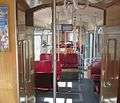 GT8N
GT8N- GT8Z
- GT8Z after being redesigned
 LCD screens detailing journey information in GT8Z 243
LCD screens detailing journey information in GT8Z 243- Combino Basic
 Urbos
Urbos
Depots
West (VAG-Zentrum)
The western depot at Besançonallee was built in the 1970s. Initially, the 100,000 square metre site served exclusively as a depot for buses, but was designed from the outset for a later takeover by the tram networtk. After the line between Bissierstraße and Haid opened in 1994, the western depot was connected to the network. Today, all the workshops and administration conducted by the VAG are located at this site next to large storage areas for buses and trams. The depot, which used to offer space for a good 50 vehicles, was expended by a further 17 bays in 2015 to create additional capacities for the Urbos.[84]
South (Urachstraße/Lorettostraße)
The southern depot located in the district of Wiehre has existed since 1901 and was until 1994 one of the two regular depots for the network. It is located on Urachstraße close to the stop for Lorettostraße. The erection of this depot was not included in the building contract of the network, but was taken over the municipal building authority. The art nouveau buildings were expanded in 1907 and 1908 around a rear house and an intermediate building. In addition, the car hall, which was initially designed for 35 vehicles, was supplemented by a further storage hall, so that 77 vehicles could be stationed after it was converted.
After the second building had been opened at the northern depot, only five course cars and buses served the depot. After the new western depot was connecting to the network in 1994, the depot lost he last remaining regular scheduled services. At the present time, vehicles of the Freunde der Freiburger Straßenbahn are accommodated in the western and older part of the depot. The eastern hall now serves the local fire brigade.
North (Komturstraße)
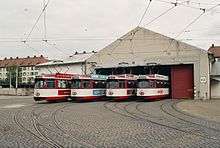
As a result of the continuous expansion of the fleet due to greater usage, the southern depot reached its full capacity limits in the 1920s. For this reason, a new depot at Komturstraße was put into operation in 1928 with the opening of the section Rennweg-Komturplatz. The five-tracked hall offered space for 30 two-axle trams. From then on, a large proportion of new trams were delivered to the northern depot, since the depot was much better connected to the road and rail network in comparison to the southern depot. The embankment to the railway station was also nearby. Moreover, with its two-sided driveway - unlike the depot at Urachstraße - it was suitable to accommodate equipment vehicles. On 15 April 1950, the second storage unit was put into operation, which could accommodate 48 additional two-axle vehicles.
After the western depot opened, the northern depot lost its importance. Until 2006, the GT8K was still used as a standstill in the storage rooms before the building was demolished in 2007 to allow for residential development of the site.[85]
Track storage (Kaiserstuhlstraße)
At the beginning of the 1920s, a track storage area was put into operation at Kaiserstuhlstraße near to the Güterbahnhof. This was connected to the network at Neulindenstraße which was built during the Second World War for lazaretto transportation. The company stationed work vehicles on site and kept a scrap yard where dismantled carriages broken up. In the 1980s, the yard was closed down and railway connections dismantled.[86]
Planning
Legislative measures until 2018
_jm57877.jpg)
Rotteckring line
As part of the reconstruction of Rotteckring, a new tramway route is currently being built from Kronenstraße, Werthmannstraße, Platz der Alten Synagogue, Rotteckring and Friedrichring to Siegesdenkmal. The 2.4 kilometre rout was expected to cost 55 million euros, but ended up costing EUR 57.5m.[87][88] Preliminary work had started in the middle of 2013.[89] Work finally began on 15 January 2015.[90] For the new route, Kronenbrücke had to replaced with a bridge suitable for trams. The sections Kronenstraße, Werthmannstraße and Platz der Alten Synagogue as well as the stops Mattenstraße and Erbprinzenstraße have almost been completed. In the middle of 2017, the junction at Siegesdenkmal and the section Rotteckring/Colombipark is still under construction. The line was opened on 16 March 2019.
Messe line (Part 2 of the first stage of construction)
The line towards the Technische Fakultät, opened in December 2015, is to be extended by two further stops from 2018 to the intersection of Madisonallee/Hermann-Mitsch-Straße, where a terminal loop and a park and ride station are to be built. Whilst a route along Emmy-Noether-Straße and parallel to the exhibition halls at the Messe were originally planned with a double crossing at Madisonallee, which according to the Federal Railway Authority would have required under- or overpassing or restriction, the section has been redesigned so that the line will now be run entirely to the west of Madisonallee.[91]
Planned tram network from 2018
Once the following two routes are opened, the following network is planned:
| Line | Route |
|---|---|
| 1 | Laßbergstraße – Musikhochschule - Schwabentorbrücke – Bertoldsbrunnen – Hauptbahnhof – Runzmattenweg – Paduaallee - Moosweiher |
| 2 | Dorfstraße – Johanneskirche - Bertoldsbrunnen – Hauptbahnhof – Robert-Koch-Straße – Friedrich-Ebert-Platz - Hornusstraße |
| 3 | Innsbrucker Straße – Heinrich-von-Stephan-Straße - Bertoldsbrunnen – Hauptbahnhof – Runzmattenweg – Am Lindenwäldle - Munzinger Straße |
| 4 | Gundelfinger Straße – Hornusstraße - Siegesdenkmal – Bertoldsbrunnen – Hauptbahnhof – Robert-Koch-Straße - Messe Freiburg[92] |
| 5 | Bollerstaudenstraße – Am Lindenwäldle - Scherrerplatz – Kronenstraße - Stadttheater – Fahnenbergplatz – Siegesdenkmal – Hornusstraße |
Medium-term plans
Messe line (second stage of construction)
The second stage of the Messe line construction is to connect Fahnenbergplatz to Robert-Koch-Straße. The crossing at the Hauptbahnhof is a problem because the existing underpass can not be used for this route. A sub-tunnelling of this section with an underground station at Hauptbahnhof Nord or a bridge could be a possibility.[93] An early realisation of this project however is not to be expected.
Extension of the line at Littenweiler
It is planned to extend the east-west axis from the present terminus at Laßbergstraße via Littenweiler Bahnhof to Kappeler Knoten.[94] Start of construction for this route is not expected before 2020.
Gundelfingen line
The route to Gundelfingen is part of the project "Stadtbahn to northern Freiburg's districts and Gundelfingen". The route is going to cross the Alte Bundestraße and run towards the terminus loop at Waldstraße.[95] At the same time, it is planned to move Gundelfingen S-Bahn station 100m to the north, in order to link the tram to the S-Bahn,
In April 2014, representative of the CDU and the Greens based in Gundelfingen launched a cross-party public opinion poll on the further development of the tramway.[96] An immediate extension is planned for a station up to Auf der Höhe, in order to better connect the local senior centres and the centre of Gundelfingen.[97]
Alternative line for Waldkircher Straße
Today's route, which is flush with roads, through Komturstraße is to be replaced in the midterm by a parallel alternative route through Waldkircher Straße, where a separate railway body is possible from the junction of the racetrack to the junction with Isfahanallee. In addition, this will give the freight yard premises a tram connection with two new stops provisionally named Zollhallenplatz and Eugen-Martin-Straße.[98][99] At the same time, as planned commissioning is to take place at the end of 2020, the existing route is to shut down.[100]
Planned tram network after 2020
Once the above routes are opened, the following network is planned:
| Line | Route |
|---|---|
| 1 | Laßbergstraße – Schwabentorbrücke – Bertoldsbrunnen – Hauptbahnhof – Runzmattenweg – Moosweiher |
| 3 | Gundelfingen Bahnhof – Gundelfinger Straße – Siegesdenkmal – Bertoldsbrunnen – Hauptbahnhof – Runzmattenweg – Munzinger Straße |
| 4 | Dorfstraße – Bertoldsbrunnen – Hauptbahnhof – Robert-Koch-Straße – Hornusstraße |
| 5 | Bollerstaudenstraße – Scherrerplatz – Bertoldsbrunnen – Siegesdenkmal – Fahnenbergplatz – Robert-Koch-Straße – Messe Freiburg |
| 7 | Innsbrucker Straße – Heinrich-von-Stephan-Straße – Stadttheater – Fahnenbergplatz – Siegesdenkmal – Hornusstraße |
Investigated measures

Connection to St. Georgen
St. Georgen, with more than 10,000 inhabitants, is Freiburg's largest district without a tram connection. Originally it was planned to continue the route from Munzinger Straße to St. Georgen Church. Such an extension is still being demanded for,[101] however it is not included in the action plan until 2020.[102] The planning of the Transport Development Plan 2020 provides two connection stages.[103]
In the first construction stage, the route is to be extended from Munzinger Straße via St. Georgen Kirche to Langgasse. For the second stage, there are five route variants.[104]
- Variant 1 (FNP-Route): St. Georgen Kirche - Obergasse - Andreas-Hofer-Straße - Vauban
- Variant 2 (FNP-Route): St. Georgen Kirche - Hartkirchweg - Hüttweg - Vauban
- Variant 3: St. Georgen Kirche - Hartkirchweg - Cardinalweg - Andreas-Hofer-Straße - Vauban
- Variant 4: St. Georgen Kirche - Hartkirchweg - Am Mettweg - Guildfordallee - Pressehaus
- Variant 5 (Branch line): St. Georgen Kirche - Cardinalweg
Gap closure at Berliner Allee
The Stadtbahn Messe is going to be connected via Berliner Allee to Bissierstraße. This route does not open up new areas, but creates the possibility of establishing new tangential lines, which could play an important role with the Stadtbahn for St. Georgen.[105]
Connection to Dietenbach
The future district of Dietenbach is also to be connected to the tram network. It is planned to extend the route at Bollerstaudenstraße in Rieselfeld by 3 or 4 stops to the Straße Am Tiergehege,[106]
Further plans
In the long-term, the following new stretches of line are also planned[107]
- Elsässer Straße (Berliner Allee - Diakoniekrankenhaus)
- Merzhausen (Paula-Modersohn-Platz - Hexentalstraße)
- Hochdorf (Madisonallee/Moosweiher - Hochdorf)
- Denzlingen (Gundelfingen - Denzlingen)
- Umkirch (Bollerstaudenstraße - Mundenhof - Umkrich)
Particular features
The tram network in Freiburg traverses three historic city gates. At the Schwabentor at the end of the 19th century, there were talks to discuss demolishing the Schwabentor, however it was decided to broaden and expand it. After the Second World War, this was teriurnd to its original state. In the German-speaking area, there were only two other such gateways, the Nauener Tor on Potsdam's tram network and the Käfigturm on Bern's.
 Schwabentor with a stepped gable (until 1954)
Schwabentor with a stepped gable (until 1954) Schwabentor
Schwabentor_jm5945.jpg) Martinstor
Martinstor Günterstäler Tor
Günterstäler Tor
From 1967, when the Lörrach tram network ceased its operations, the route to Günterstal was the southernmost tram route in Germany. This was the case until 2014, when Basel extended its network to Weil am Rhein.
The Stühlinger Bridge ("Stadtbahnbrücke") is the steepest section of Freiburg's tramway network. For this reason, the GT8s were equipped with all-wheel drive.
Further reading
- Dietmar Gemander, Thomas Hettinger: Die Freiburger Straßenbahn. Die Zeit vor der Stadtbahn., EK-Verlag, Freiburg im Breisgau 2006, ISBN 3-88255-845-8.
- Mobile Stadt – Die Geschichte der Straßenbahn in Freiburg., Freiburger Verkehrs AG, Freiburg im Breisgau 2001, ISBN 3-00-008339-1.
- Wolfdieter Batsch: Die Freiburger Stadtbahn: ein Jahrhundertwerk kurz vor seiner Verwirklichung., Freiburger Stadthefte, Band 24, Rombach, Freiburg im Breisgau 1977.
- Norman Kampmann, Christian Wolf: Die Freiburger Straßenbahn heute. Mit der Freiburger Verkehrs AG durch die Breisgaumetropole., EK-Verlag, Freiburg im Breisgau 2012, ISBN 3-88255-499-1.
- Joachim Scheck, Daniel Charhouli: STRABA: Freiburg auf Gleisen entdecken, Promo-Verlag, Freiburg im Breisgau 2014, ISBN 978-3-923288-78-6.
References
Notes
- Manfred Gallo: Freiburg: Der „Hoobl“ fährt seit 107 Jahren. Badische Zeitung, 3. November 2008, abgerufen am 21. März 2014.
- Peter_Kalchthaler: Wo fuhr einst Freiburgs erster Omnibus? Badische Zeitung, 6 Februar 2012; retrieved, 13 June 2014.
- Viktor Kuntzemüller: Freiburgs Bächle einst und jetzt Archived 2015-06-29 at the Wayback Machine. In: Freiburger Almanach. 38, 1987.
- Freiburger Zeitung, Ausgabe vom 1. September 1901.
- Simone Höhl: Hochfrisur und Tiefenanalyse: Die Risse im Schwabentor sind noch immer ein Rätsel. Badische Zeitung, 30. Januar 2013, abgerufen am 13. Juni 2014.
- Dietmar Gemander, Thomas Hettinger: Die Freiburger Straßenbahn. Die Zeit vor der Stadtbahn. EK-Verlag, Freiburg 2006, ISBN 3-88255-845-8, S. 15: Erste Streckenerweiterungen.
- Freiburger Verkehrs AG: Mobile Stadt – Die Geschichte der Straßenbahn in Freiburg. 2001, S. 19 (Betriebsbericht 1902: Einheitliche Tarife für die Straßenbahn).
- Gerhard Greß: Verkehrsknoten Freiburg und seine Umgebung in den fünfziger und sechziger Jahren. EK-Verlag, Freiburg 1997, ISBN 3-88255-263-8, S. 11.
- 100 Jahre Straßenbahn in Zähringen, auf nahverkehr-breisgau.de, abgerufen am 13. Juni 2014.
- Dietmar Gemander, Thomas Hettinger: Die Freiburger Straßenbahn. Die Zeit vor der Stadtbahn. EK-Verlag, Freiburg 2006, ISBN 3-88255-845-8, S. 21–23: Planungen und Streckenerweiterungen zwischen 1910 und 1914.
- Freiburger Verkehrs AG: Mobile Stadt – Die Geschichte der Straßenbahn in Freiburg. 2001, S. 36 (Betriebsbericht 1915: Einzug des Fahrpersonals und erstmalige Anstellung von Frauen).
- L. Werthmann (Hrsg.): Die Freiburger Lazarette im Völkerkrieg: 1914/15. Caristasverlag, Freiburg im Breisgau 1915, S. 152/153.
- Morgenausgabe, Freitag, 13. Oktober 1916.
- Freiburger Zeitung, Freiburger Zeitung, Abendausgabe, Freitag, 13. Oktober 1916.
- Dietmar Gemander, Thomas Hettinger: Die Freiburger Straßenbahn. Die Zeit vor der Stadtbahn. EK-Verlag, Freiburg 2006, ISBN 3-88255-845-8, S. 27: Die Zeit nach dem Ersten Weltkrieg.
- Andreas Peikert: Seit 100 Jahren gehört Littenweiler zu Freiburg. Badische Zeitung, 8. Januar 2014, abgerufen am 13. Juni 2014.
- Manfred Gallo: Das Gasthaus an den Gleisen. Badische Zeitung, 1. Februar 2010, abgerufen am 13. Juni 2014.
- Dietmar Gemander, Thomas Hettinger: Die Freiburger Straßenbahn. Die Zeit vor der Stadtbahn. EK-Verlag, Freiburg 2006, ISBN 3-88255-845-8, S. 33: Die 30er-Jahre.
- Freiburger Verkehrs AG: Mobile Stadt – Die Geschichte der Straßenbahn in Freiburg. 2001, S. 77 (Betriebsbericht 1933: Tarifänderungen).
- Heiko Hauman, Dagmar Rübsam, Thomas Schnabel, Gerd R. Ueberschär: Hakenkreuz über dem Rathaus. Von der Auflösung der Weimarer Republik bis zum Ende des Zweiten Weltkrieges (1930–1945). In: Geschichte der Stadt Freiburg im Breisgau. Band 3, Theis, Stuttgart 1992, ISBN 3-8062-0857-3, S. 353 f.
- Dietmar Gemander, Thomas Hettinger: Die Freiburger Straßenbahn. Die Zeit vor der Stadtbahn. EK-Verlag, Freiburg 2006, ISBN 3-88255-845-8, S. 36–37: Der Obus-Verkehr.
- Freiburger Verkehrs AG: Mobile Stadt – Die Geschichte der Straßenbahn in Freiburg. 2001, S. 83 (Betriebsbericht 1944/45: Schäden nach dem Bombenangriff am 27. November 1914).
- Städtische Straßenbahn Freiburg i. Br., Artikel für „Fahr Mit“, 4. November 1953.
- Die Triebwagen des Typs Sputnik auf www.nahverkehr-breisgau.de
- Hans Sigmund: Freiburg Nord: Als die Tram zum Kirchplatz fuhr. Badische Zeitung, 22. März 2010, abgerufen am 7. Februar 2013.
- Wiehre-Journal Nummer 19 Archived 2014-03-12 at the Wayback Machine, November/Dezember 2009.
- Stilllegungsdaten Freiburg im Breisgau, auf www.sufk-koeln.de, abgerufen am 13. Juni 2014.
- Wendeschleife Komturplatz verlegt, in der Rubrik Freiburg vor 50 Jahren der Badischen Zeitung, Ausgabe vom 4. Mai 2010, abgerufen am 13. Juni 2014.
- Greß, Gerhard (1997). Verkehrsknoten Freiburg und seine Umgebung in den fünfziger und sechziger Jahren. EK-Verlag, Freiburg. p. 49. ISBN 3-88255-263-8.
- Heiner Monheim, Rita Manheim-Dandörfer: Straßen für alle. Analysen und Konzepte für den Stadtverkehr der Zukunft. Rasch und Röhring, Hamburg 1990, ISBN 3-89136-368-0, S. 417.
- Freiburger Verkehrs AG: Mobile Stadt – Die Geschichte der Straßenbahn in Freiburg. 2001, S. 165
- Joachim Wille: Die Tempomacher – Freie Fahrt ins Chaos. C. H. Becksche Verlagsbuchhandlung, München 1988, ISBN 3-406-33026-6, S. 162–168.
- Heiner Monheim, Rita Manheim-Dandörfer: Straßen für alle. Analysen und Konzepte für den Stadtverkehr der Zukunft. Rasch und Röhring, Hamburg 1990, ISBN 3-89136-368-0, S. 418.
- 15 Jahre RegioKarte Archived 2015-09-24 at the Wayback Machine, auf rvf.de, abgerufen am 13. Juni 2014.
- "Tramfans machen mächtig Dampf – badische-zeitung.de" (in German). Retrieved 2014-12-15.
- Wolfgang Plöger u.a.: Wir halten Freiburg in Bewegung seit 1901. Dokumentation des öffentlichen Personennahverkehrs der Stadt Freiburg i.Br. Broschüre der Freiburger Verkehrs AG, Freiburg i. Br. 1991.
- Amtsblatt Freiburg: Eröffnung Stadtbahn Haslach, abgerufen am 13. Januar 2014.
- VAG Freiburg: Eröffnungsfest Stadtbahn Vauban 4. April 2006, abgerufen am 17. Januar 2014.
- Amtsblatt Freiburg: Stadtbahn Vauban: Trasse zwischen Basler Straße und Vauban 9. Oktober 2003, abgerufen am 17. Januar 2014.
- Amtsblatt vom 29. April 2006, Seite 4, abgerufen am 26. August 2014
- Amtsblatt Freiburg:Umgestaltung der Habsburgerstraße, Sonderbeilage am 5. November 2009, abgerufen am 13. Juni 2014.
- Stadt Freiburg: Sanierung und Umgestaltung Schwarzwaldstraße.
- Bahn frei für Linie 2 – Einweihung am Samstag, badische-zeitung.de, 12. März 2014, abgerufen am 26. August 2014
- Simone Höhl: Wieder Weichenbruch am Bertoldsbrunnen – im Juni kommt die Generalsanierung. Badische Zeitung, 8. Mai 2014, abgerufen am 26. Oktober 2014.
- Simone Höhl: Handarbeit in der Mösleschleife. Badische Zeitung, 21. Juni 2014, abgerufen am 26. Oktober 2014.
- Joachim Röderer: Tram fährt rund um die Uhr. Badische Zeitung, 8. März 2014, abgerufen am 31. Januar 2016.
- Sina Gesell: Ein Jahr Nachtverkehr mit Bus und Bahn: Wie läuft’s? Badische Zeitung, 3. Dezember 2015, abgerufen am 31. Januar 2016.
- Uwe Mauch: Freiburg: Spatenstich für die 38 Millionen Euro teure Tramtrasse zum Messegelände. Badische Zeitung, 15. Juni 2013, abgerufen am 16. Juni 2013.
- Simone Höhl, Joachim Röderer: Premiere in Pink: Die Linie 4 rollt in den Freiburger Westen. Badische Zeitung, 12. Dezember 2015, abgerufen am 22. Dezember 2015.
- VAG: Zahlen & Fakten, Stand 2012, abgerufen am 13. Juni 2014.
- "Freiburg im Breisgau auf strassenbahn-online.de" (in German). Retrieved 2014-06-13.
- Michael Flösch, VAG-Betriebsleiter im Bereich „Instandhaltung Elektrischer Anlagen“, Stand 16. Juli 2014
- "Siegesdenkmal und Kajo: Die neuste Stau- und Baustelle – badische-zeitung.de" (in German). Retrieved 2017-06-03.
- Simone Höhl (2016-12-27). "Freiburg: Korrektur: Lassbergstraße heißt jetzt Laßbergstraße" (in German). Badische Zeitung. Retrieved 2017-04-29.
- Taktisch überlegen – mit Mit Bus und Bahn ins MAGE SOLAR Stadion Archived 2014-02-03 at the Wayback Machine, abgerufen am 17. Februar 2014.
- "Freiburg und Umgebung: Aus der Tram in Taxi und Bus: So funktioniert der Nachtverkehr – badische-zeitung.de" (in German). Retrieved 2014-12-14.
- "VAG safer traffic: Freiburger Verkehrs AG" (in German). Archived from the original on 2014-12-14. Retrieved 2014-12-14.
- Tramtoms Seite für die Tram in Freiburg, abgerufen am 13. Juni 2014.
- Kursnummern auf tramtom.de, abgerufen am 13. Juni 2014.
- VAG Preisinformaton, abgerufen am 14. Oktober 2016.
- Simone Lutz: Warum verkaufen Freiburger Straßenbahnfahrer keine Tickets mehr?, Badische Zeitung, 10. Februar 2016, abgerufen am 10. Februar 2016.
- Herderner Bürgerbrief, Oktober 2009 Archived 2014-02-25 at the Wayback Machine, abgerufen am 13. Juni 2014.
- Stadtbahn Haslach, auf zrf.de, abgerufen am 14. Juni 2014.
- VAG Freiburg: "Neuer Nachtverkehr", 21. Dezember 2014, abgerufen am 13. November 2015.
- Wagenparkliste Ulm: Arbeitswagen, auf tram-info.de, abgerufen am 22. Juni 2014.
- Blickpunkt Straßenbahn Ausgabe 1/2017, S. 102.
- Norman Kampmann, Christian Wolf: Die Freiburger Straßenbahn heute. Mit der Freiburger Verkehrs AG durch die Breisgaumetropole (Stadtverkehr-Bildarchiv, Band 2). EK-Verlag, Freiburg 2012, S. 10–13: Fahrzeuge für den Stadtbahnbetrieb.
- Nahverkehr Breisgau: "GT8 Einrichtungstriebwagen 3.Serie". Archived from the original on January 24, 2010. Retrieved 2014-06-22., abgerufen am 22. Juni 2014.
- Simone Höhl: Renovierung: Die Verkehrs-AG modernisiert ihre größte Straßenbahnflotte. Badische Zeitung, 22. September 2013, abgerufen am 11. Februar 2013.
- Nahverkehr Breisgau: "Was geschah mit Wagen 272?". Archived from the original on June 12, 2010. Retrieved 2014-06-22., abgerufen am 22. Juni 2014.
- tenders electronic daily Lieferauftrag – 58336-2013, abgerufen am 13. Juni 2014.
- Rolf Müller: VAG kauft Trams bei spanischem Hersteller. Badische Zeitung, 25. Februar 2013, abgerufen am 13. Juni 2014.
- 12 neue Stadtbahnwagen vom Typ „Urbos 100“ für Freiburg at the Wayback Machine (archive index) , Freiburger Verkehrs AG, 15. März 2013.
- "Ankunft: Freiburgs neue Straßenbahnen: Der Urbos ist da – badische-zeitung.de" (in German). Retrieved 2015-03-18.
- "Freiburg: Premiere: VAG feiert Start des Urbos-Zeitalters – Jungfernfahrt durch Freiburg – badische-zeitung.de" (in German). Retrieved 2015-10-23.
- "Freiburg: Neue Strassenbahn: Der Urbos startet in Freiburg – BZ testet neue Tram – badische-zeitung.de" (in German). Retrieved 2015-07-16.
- Simone Höhl (2016-05-21). "Freiburg: Urbos haben sich etabliert – manchen sind sie jedoch zu eng" (in German). Badische Zeitung. Retrieved 2016-05-22.
- Simone Höhl (2017-02-28). "Freiburg: Die neuen Urbos-Straßenbahnen rollen an" (in German). Badische Zeitung. Retrieved 2017-03-01.
- Blickpunkt Straßenbahn Ausgabe 4/2017, S. 106.
- Informationen zur Oldtimerlinie 7, auf stadt-land-regiokarte.de, abgerufen am 13. Juni 2014.
- Nahverkehr Breisgau: "Arbeitswagen". Archived from the original on January 23, 2010. Retrieved 2014-03-07., abgerufen am 13. Juni 2014.
- Freiburger Verkehrs AG: Mobile Stadt – Die Geschichte der Straßenbahn in Freiburg. 2001, S. 103 (Wie die Reklame ins Rollen kam).
- "Freiburg: Schiffmann Außenwerbung: Straßenbahnen in Freiburg sind seit fast 100 Jahren mobile Werbeflächen" (in German). Badische Zeitung. Retrieved 2016-01-12.
- Simone Höhl: Freiburg: Die VAG baut die längste Garage der Stadt. Badische Zeitung, 8. Juni 2013, abgerufen am 23. Februar 2014.
- VAG Freiburg: Betriebshof Nord wird verkauft, abgerufen am 13. Juni 2014.
- Nahverkehr Breisgau: "Verschrottungen". Archived from the original on January 23, 2010. Retrieved 2014-03-09..
- Uwe Mauch: Kostenexplosion: Stadtbahn über Rotteckring wird knapp 17 Millionen Euro teurer. Badische Zeitung, 29. Juni 2013, abgerufen am 21. Juli 2013.
- Uwe Mauch: Kostenexplosion bei Rotteckring-Linie: Stadträte warten auf Erklärungen. Badische Zeitung, 3. Juli 2013, abgerufen am 21. Juli 2013.
- Simone Höhl: Bau der Stadtbahn über den Rotteckring startet im Februar. Badische Zeitung, 26. September 2014, abgerufen am 26. September 2014.
- VAG: Spatenstich für die Stadtbahn Rotteckring, Pressemitteilung vom 15. Januar 2015, abgerufen am 16. Januar 2015.
- Simone Lutz (2013-08-14). "Neue Pläne für die Straßenbahn zur Messe". Badische Zeitung (in German). Retrieved 2015-10-21.
- "Freiburg: Linie 4 fährt pink zur Messe – badische-zeitung.de" (in German). Retrieved 2015-07-16.
- Uwe Mauch: Freiburg: Straßenbahnlinie wird teurer und kommt mit Verspätung. Badische Zeitung, 10. Mai 2013, abgerufen am 11. April 2014.
- Uwe Mauch: Freiburg: Politischer Vorstoß für die Linie 1. Badische Zeitung, 23. Februar 2012, abgerufen am 26. Januar 2014.
- Gundelfingen: Gundelfingen-Süd kann nur Zwischenlösung sein. Badische Zeitung, 17. Februar 2012, abgerufen am 12. Januar 2014.
- "Bündnis 90/Die Grünen: Bürgerbefragung zur Straßenbahn" (PDF). Archived from the original (PDF) on May 4, 2014. Retrieved 2014-05-04. , abgerufen am 4. Mai 2014.
- Andrea Dreschner: Gundelfingen: Straßenbahn bis zum „Ochsen“? Badische Zeitung, 26. April 2014, abgerufen am 4. Mai 2014.
- Uwe Mauch: Freiburg: Eine neue Trasse für die Tram im Norden. Badische Zeitung, 29. Juni 2010, abgerufen am 23. Januar 2014.
- "Freiburg: Kleine Tramtrasse, große Kostensteigerung – badische-zeitung.de" (in German). Retrieved 2015-06-16.
- Bebauungspläne im Verfahren Stadtbahn Waldkircher Straße. freiburg.de, abgerufen am 5. Juli 2016.
- Beteiligungshaushalt Freiburg: Wann bekommt St. Georgen endlich einen Straßenbahnanschluss? Archived 2014-02-02 at the Wayback Machine 15. Januar 2013, abgerufen am 18. Januar 2014.
- Unabhängiger Bürgerverein St. Georgen: Stadtbahn St. Georgen in weite Ferne gerückt. Archived 2013-09-25 at the Wayback Machine 5. Juni 2010, abgerufen am 18. Januar 2014.
- Stadt Freiburg: Verkehrsentwicklungsplan 2020: Untersuchte Maßnahmen im ÖPNV. S. 1–9, abgerufen am 4. November 2014.
- Stadt Freiburg: Verkehrsentwicklungsplan 2020: Untersuchte Maßnahmen im ÖPNV (Bild), abgerufen am 4. November 2014.
- Stadt Freiburg: Verkehrsentwicklungsplan 2020: Untersuchte Maßnahmen im ÖPNV. S. 10–12, abgerufen am 4. November 2014.
- Stadt Freiburg: 3. Infobrief zum Stadtteil Dietenbach, Vertiefungsstudie zur städtebaulichen Testplanung, abgerufen am 5. Mai 2016.
- Andrea Gallien: Merzhausen: Stadtbahn ist noch Thema. Badische Zeitung, 20. Oktober 2011, abgerufen am 22. März 2014.
Bibliography
- Gemander, Dietmar; Hettinger, Thomas (2006). Die Freiburger Straßenbahn [The Freiburg Tramway] (in German). Freiburg i. B., Germany: EK-Verlag. ISBN 3882558458.
- Höltge, Dieter (1999). Straßen- und Stadtbahnen in Deutschland [Tramways and Stadtbahnen in Germany] (in German). Band 6: Baden [Volume 6: Baden]. Freiburg i. B., Germany: EK-Verlag. ISBN 3882553375.
External links
![]()
- Freiburger Verkehrs AG (official website) (in German)
- Freiburg im Breisgau database / photo gallery and Freiburg im Breisgau tram list at Urban Electric Transit – in various languages, including English.
- Freiburg im Breisgau database / photo gallery at Phototrans – in various languages, including English.
- List of town tramway systems in Germany
- Trams in Germany
